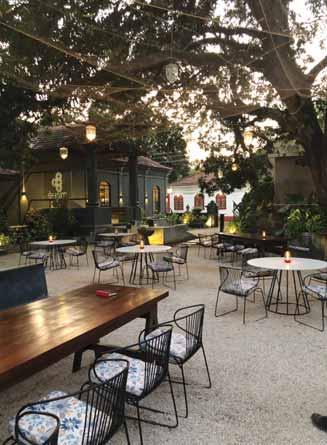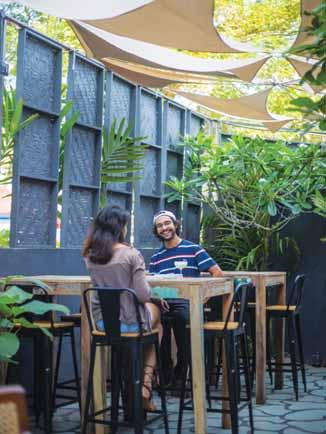
































Subscription in charge
Kalpana kalpana@rotarynewsonline.org
Sasikala sasi@rotarynewsonline.org
Valli valli@rotarynewsonline.org
Anuvarshini anu@rotarynewsonline.org
District numbers
2982, 3020, 3054, 3090, 3100, 3170, 3181, 3182, 3190, 3250, 3262
2981, 3012, 3110, 3120, 3141, 3142, 3201, 3211, 3212, 3261, 3291
3000, 3030, 3060, 3070, 3080, 3131, 3132, 3232, 3240
3011, 3040, 3053, 3150, 3160, 3202, 3231
You can reach our Subscription chief Senthil Kumar on senthil@rotarynewsonline.org
You can also call 044-42145666 or 9840078074, ask for the subscription person in charge of your district, and lodge a complaint.
But above all, make sure of the following:
1. You have paid your Rotary News dues to your club.
2. The club has sent the dues to Rotary News Trust.
3. Your name and full postal address, with the correct pincode, and preferably email and phone number, are given to us.
Despite the Covid pandemic challenges the Rotary News Trust team is regularly bringing out and despatching the magazine on time every month. We are doing the best possible to ensure that all our subscribers get the magazine on time. But we continue to receive complaints that some of you are not receiving their copies.
The reasons could be:
• Change in address, about which we are not aware. If you don’t receive your copy, please send us a mail immediately, attaching your latest address, and old one with correct pin code if you haven’t moved. Reach us at rotarynews@rosaonline.org
• Kindly remember that even if your latest details are with RI’s South Asia office, we have no access to that data. Repeated attempts to get that data have failed, because of RI’s privacy policy. So please communicate with us directly.
• Please check with your postman or post office when you do not get your copy.
• Club officers, please regularly update us when members leave or new members join. If you do not tell us when a member leaves, he/ she continues to get the magazine, without paying for it. And the new member who joins, will not get it, despite paying his subscription dues, because the Rotary News Trust office has no information about the new member.
• Do also remember that subscribing to any one Rotary magazine — The Rotarian (now titled Rotary), or a regional magazine, is mandatory for all Rotarians as stipulated by RI in its Manual of Procedure. Not doing so can result in suspension of the club.


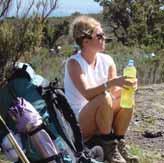
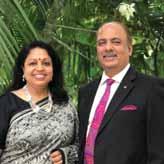


12 Cycling for humanitarian causes
Young Rotarian Naresh Kumar cycled 8,646 km from Chennai to the Hamburg Convention.
20 Let’s make Rotary an organisation of choice that doesn’t need marketing
In an interview to Rotary News, incoming RI Director A S Venkatesh shares his personal and Rotary journey.
32 Tell your Rotary stories to grow our organisation
At the zone institute, The Odyssey, RIPN Jennifer Jones held the audience spellbound with her gripping account of climbing Kilimanjaro’s peak.
36 Scaling up WASH projects
Details of the upcoming WASH programmes planned by Rotarians in India.
38 Covid vaccination is important, but polio eradication is our DNA
RIPE Shekhar Mehta and Rashi have a tete-a-tete with RID Kamal Sanghvi at the opening session of the International Assembly.
60 Creating your own ‘black gold’ at home
Learn to generate rich humus for your plants from your kitchen waste.
64 Geeta Dutt: the ballerina of song
This inimitable singer gave Bollywood some of its most lilting songs during the late 1940s and 1950s.
70 Peace on earth, mercy too
A peek into Australian entrepreneur Steve Killelea’s book that attempts to decipher the psyche behind why countries engage in war.
On the cover: Rtn Naresh Kumar, who cycled from Chennai to Hamburg, on one of his running events.

Inspiring story on beautician training
Gladto see the beautiful cover photo of Project ‘Sundari’ sponsored by RID 3232, which will change the lives of 100 differently-abled, but energetic young women. In her note, the Editor has vividly described young leaders making a difference in the world. RI directors have explained well the importance of maternal and child care. Saddened to read that 11 million girls may stop going to school due to the pandemic. Speeches made by Rotary leaders at IA 2021 are inspiring. Empowering women through ornamental fish farming is interesting. Articles on Finland’s PM Samma Marin and Hindustani music’s vox populi Bhimsen Joshi are interesting. The 5Rs of waste management is a useful article
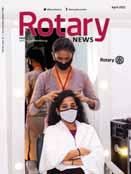
YetPhilip Mulapone M T, RC Trivandrum Suburban — D 3211
again Rasheeda and her team have given us an issue that ranks with the best. The LBW column brought back memories of my school life. The editorial highlighted the good work being done by a Cuban doctor which Rotaractors should read. The editor has a nose for news that brings us valuable information on so many subjects. Trustee Chair K R Ravindran’s call to clubs to partner with other organisations is welcome. Jaishree’s cover story on beauticians’ training is superb. It is good
The April issue is interesting as usual; RI President Holger Knaack stressed the need for Rotarians to expand their services to preserve the earth, while addressing the DGEs and DGNs at IA 2021.
R Srinivasan, RC Madurai Midtown — D 3000
RI President Holger Knaack has rightly said in his message that Rotaractors do good work which is more or less equal to that of Rotarians. I agree with the Editor that women were allowed into Rotary only in 1987, which is rather late. However, we look forward to the
to know PDG Rekha Shetty initiated this project. I was shocked that 11 million girls may not return to school this year due to the pandemic. Muthukumaran’s article on the new Rotary models was interesting.
Nan Narayenen, RC Madurai West — D 3000
TheApril issue is a compendium of educative articles. The cover page is inspiring. RID 3232 has done a good job to train 100 girls to make them self-reliant. The Editor’s note on influential youngsters is useful as are the articles on the Ganga river and the training of district leaders. Coverage of club projects gives inspiration to all of us. Pandit Bhimsen Joshi was a legend of Indian music. We are thankful for the article on him.
Anujj Agarwal, RC Chandausi City Star — D 3100
Thecover photo and project story say a lot about Rotary vision on women’s empowerment. RC Bhubaneswar Ekamra Kshetra has enhanced the livelihood of rural women through ornamental fishing. RC Patiala Midtown offering training in stitching to underprivileged women deserves appreciation.
Naveen Ramesh Garg RC Sunam — D 3090
first woman RI President (Jennifer Jones) who will be taking charge on 2022–23. The article on the gear man of Coimbatore is informative.
S Muniandi, RC Dindigul Fort — D 3000
PRIP Rajendra Saboo’s reminiscences on polio were interesting. The photo of Rukhsar, the last polio victim, on the cover page (March’21) was appropriate and nostalgic. RIPE Shekhar Mehta’s interview brought out some fascinating aspects of his personality.
V G Deodhar RC Nasik — D 3030
Rotary News has now become a multifaceted magazine. The March issue offered diverse articles on the Zambia Malaria project, opportunities for Indian pharma and avoidable deafness.
Soumitra Chakraborty RC Calcutta Innovation — D 3291
I always look forward to Rotary News ; Earlier I worked at Dugar Tower in Chennai and later moved to Bengaluru. By then Rasheeda Bhagat took over as Editor. The Hindu’s loss is Rotary’s gain.
Murali Krishnan, RC Bangalore Lakeside — D 3190
Coimbatore’s ‘gear man’
The article on Coimbatore’s ‘gear man’ who did selfless service is most welcome as it elucidates how some people have made service their business without expecting anything in return. It is great that Rotary News published an article on Subramanian; it is indeed a feather in your cap. Keep it up.
Rm Muthukaruppan
RC Sankarapuram — D 2982
RID Kamal Sanghvi has presented a number of statistics to show the looming water crisis in India (March issue). He has rightly said that while a very few people die of thirst, millions die from preventable waterborne diseases. The five-year target of Rotary in water and sanitation projects is commendable.
Dr Pon Muthaiyan
RC Aduthurai — D 2981
The March issue was well-designed and informative. Congrats to RC Howrah for donating a bicycle to Rukhsar Khatoon, the last polio victim in India, whose photo riding the cycle was aptly put on the cover page. Hats off to Coimbatore man, Subramaniam for his contributions to society. Thank you for a beautiful magazine.
Shraddha P, RC Thane Green City — D 3142
The March issue had a lot of interesting content. The Editor’s note A leader par excellence was fantastic. Also, the report Celebrating 10 years of polio-free India was magnificent. Goodies for Rukhsar by TRN was excellent. Jaishree’s report on Coimbatore’s ‘gear man’ who did
selfless service is an inspiration to all Rotarians.
Daniel Chittilappilly RC Kaloor — D 3201
I appreciate the coverage given to the milestone of 10 years of poliofree India. I was touched to see the photo of the late RI director Y P Das in the group photo. He was a dedicated Rotarian and his contribution to Rotary’s humanitarian projects is unforgettable. He had an important role to play in India becoming polio-free.
Dr Suresh K Sablok, RC Nahan Sirmour Hills — D 3080
The March editorial ( A leader par excellence ) has rightly focused on the gender imbalance in Rotary. It is appreciable that RIPN Jennifer Jones is aiming to correct the imbalance. But gender inequity exists not only in Rotary but everywhere. No nation can progress by neglecting its women.
Raj Kumar Kapoor RC Roopnagar — D 3080
Give priority to girls’ education
Although girls’ education is affected due to Covid, Rotarians can bring about a change by
rendering service either by increasing awareness or by making school education free in all types of institutions. Like Project Positive Health, girls’ education should be an issue where TRF grant should be available avoiding gender discrimination.
Arun Kumar Dash RC Baripada — RID 3262
We are glad that you gave space in Rotary Plus for our Covid vaccination camp. This will encourage our club members. Thank you.
Manoj R Kumar RC Agra — D 3110
A novel way to collect TRF funds
As a club president, I share my experiment of TRF collection. I first donated $1,000 to TRF. Then I requested my friends and other Rotarians for donations on Whatsapp and Facebook, sharing information about TRF. I said I’d accept $10 cheques too. As I started getting cheques, I published their names on Whatsapp groups. In one month, I collected $3,000 as donation. My aim is to collect $5,000 for TRF in this pandemic time.
Madhukar Doiphode RC Barsi — D 3132
We welcome your feedback. Write to the Editor: rotarynews@rosaonline.org; rushbhagat@gmail.com. Mail your project details, along with hi-res photos, to rotarynewsmagazine@gmail.com
Messages on your club/district projects, information and links on zoom meetings/ webinar should be sent only by e-mail to the Editor at rushbhagat@gmail.com or rotarynewsmagazine@gmail.com WHATSAPP MESSAGES WILL NOT BE ENTERTAINED.
Click on Rotary News Plus in our website www.rotarynewsonline.org to read about more Rotary projects.

or years, Susanne and I hosted many Rotary Youth Exchange students in our home. This programme was an entry point to Rotary for me, and my heart is truly in it. When Rotary’s exchange programmes were suspended because of Covid-19 to keep students and families safe, we felt sorry, especially for the participants, because those years cannot be repeated.
Because of the many uncertainties of the pandemic, the Rotary Board has decided to suspend in-person exchanges through June 2022. As we look ahead with hope, we thank Youth Exchange officers, host families, and other volunteers for their contributions in years past. We are hopeful that in-person exchanges will be back next year. And because of the many uncertainties, we’re encouraging districts to offer virtual exchanges as a way of connecting students, families and volunteers.
For those who are not able to participate in Rotary Youth Exchange, Rotary offers other opportunities. New Generations Service Exchange (NGSE) is a Rotary programme that deserves wider recognition. It is an excellent opportunity for young people ages 18 to 30 to participate in community service as individuals or in a group and to gain internship experience. Simukai Matshalaga, a Rotaractor from Zimbabwe, stayed with us in Ratzeburg during her NGSE experience three years ago.
When I applied for the New Generations Service Exchange programme, I did not realise that I was signing up for a life-changing experience. This programme gave me that opportunity and much more. It taught me about the importance of failing fast, learning quicker, and being myself.
Some of my greatest experiences happened at the dinner table. The warmth and kindness of every home I lived in still resonate with me today. It took
me weeks to understand how a stranger could care for me as deeply as these members of the Rotary family did. I am inspired by the lessons of humility I learned from all the amazing people I met. I came to understand a new culture and realised that the only things that separate us as people are our experiences and, at times, our false assumptions.
Professionally, it gave me confidence in my own abilities as an engineer. Seeing how other organisations handled problems made me aware that the best person to solve the challenges in my country was me. Returning home from northern Germany, I declined a promotion, quit my job, and began building a family business — a decision that previously I would have never made, out of fear.
I am indebted to the Rotary family. I am not sure whether the friends, mentors, and families I left behind knew that they changed my life permanently. I hope they now do.
New Generations Service Exchange changed Simukai’s life. It can change yours, too. All Rotary members can experience something similar at any time: I encourage everyone to take a virtual journey this month and visit meetings of other clubs online. You will see how different Rotary is around the world as you meet great people and make new friends.
Let us build upon these connections forged online — and later, when the time is right, enjoy in-person exchanges with them through Rotary Friendship Exchange, another excellent programme for Rotary members of all ages.
Our ability to meet in-person is limited now, but we know that Rotary Opens Opportunities, always. Now is the time to get ready, so that when the pandemic is behind us, Rotary’s exchange programmes will come back stronger than before, serving a world that is yearning to reconnect.
Holger Knaack President, Rotary International


second, and much more devastating wave of the Covid pandemic has brought India and its citizens down to their knees. With over three lakh new cases being detected every single day, we have become untouchables in countries such as Australia, Canada, New Zealand, etc. And as I write this edit on April 23, even UAE and Singapore have imposed restrictions on Indians. At long last, even the judiciary came down heavily upon the administration; the Supreme Court describing the situation as “grim”, urged the government to come out with a national plan as distressed citizens were moving various High Courts for relief. The same morning, newspapers front-paged the picture of a desperate man seated under a tree, connected to an oxygen cylinder, outside a Delhi hospital, as he waited for a bed. Stories from the crematoriums were heart-breaking.
I just did not have enough courage to even open the spate of videos landing up in my inbox about desperate relatives crying for oxygen and some medical care outside hospitals. Chennai’s premier hospitals had 10–15 ambulances lined up outside their emergency rooms. Eminent virologist and Rotarian Dr Jacob John, who was at the forefront of the strategy to rid India of polio, was quoted thus by the Hindu Business Line: “We not only did not anticipate the second wave, but also neglected our genomic analysts. It is a pity that we have the wherewithal, the labs, the people and the expertise, but we just did not care, because the number of cases were coming down.” Other experts feared that things will get much worse before they get better.
We were once proud of our superior medical expertise and robust, sterling healthcare system manned by among the best in the world, and proudly promoting medical tourism. But this pandemic has stretched our health care system to its extreme limits. Did we ever imagine that a Delhi
High Court judge would say: “Forget the common man on the street, even if I were to ask for a bed today, it would not be available right now”. Worse still, people are dying for want of oxygen. In this context Apollo Hospitals Joint MD Sangita Reddy’s tweet urging government to allow the tag of ‘ambulance’ to oxygen tankers, made abundant sense.
But at the end of the day, a major chunk of the blame for this state of affairs across the country is our laxity in taking precautions, maintaining social distancing, wearing masks, and attending huge religious and other gatherings, including political rallies, and that too without adequate protection. Forget the uneducated people, even the most educated people have behaved irresponsibly. But the silver lining in the cloud is the enthusiastic manner in which Rotary, led by past RI director Ashok Mahajan, is assisting the government in vaccinating people against Covid. And the way Rotarians are using the Rotary network to help as many people as they can to get speedy access to medical care in an emergency.
Yes, some of those who have taken both the vaccine shots have once again been infected, by a mutant or variant of the virus. But the good news is that after vaccination is completed, the mortality rate is greatly reduced, in case of infection. In all the mayhem that we have seen, one politician who has given sane advice is the Delhi chief minister Arvind Kejriwal. Through media advertisements he has been appealing to Delhiites to behave responsibly and get vaccinated, cautioning them that this time around the virus has been viciously attacking people below 45, and so on. Of course, his attempt to live telecast a meeting of CMs chaired by PM Narendra Modi was inexcusable, and he got a deserved rap for it too from the PM.
Such wise and measured counsel is needed from more of our politicians instead of blame game. But we need to listen… and act.
Rasheeda Bhagat
RI Dist 2981
RI Dist 2982
RI Dist 3000
RI Dist 3011
RI Dist 3012
RI Dist 3020
RI Dist 3030
RI Dist 3040
RI Dist 3053
RI Dist 3054
RI Dist 3060
RI Dist 3070
RI Dist 3080
RI Dist 3090
RI Dist 3100
RI Dist 3110
RI Dist 3120
RI Dist 3131
RI Dist 3132
RI Dist 3141
RI Dist 3142
RI Dist 3150
RI Dist 3160
RI Dist 3170
RI Dist 3181
RI Dist 3182
RI Dist 3190
RI Dist 3201
RI Dist 3202
RI Dist 3211
RI Dist 3212
RI Dist 3231
RI Dist 3232
RI Dist 3240
RI Dist 3250
RI Dist 3261
RI Dist 3262
RI Dist 3291
DG R Balaji Babu
DG K S Venkatesan
DG A L Chokkalingam
DG Sanjiv Rai Mehra
DG Alok Gupta
DG Muttavarapu Satish Babu
DG Shabbir Shakir
DG Gajendra Singh Narang
DG Harish Kumar Gaur
DG Rajesh Agarwal
DG Prashant Harivallabh Jani
DG CA Davinder Singh
DG Ramesh Bajaj
DG Vijay Arora
DG Manish Sharda
DG Dinesh Chandra Shukla
DG Karunesh Kumar Srivastava
DG Rashmi Vinay Kulkarni
DG Harish Motwani
DG Sunnil Mehra
DG Dr Sandeep Kadam
DG Nalla Venkata Hanmanth Reddy
DG B Chinnapa Reddy
DG Sangram Vishnu Patil
DG M Ranganath Bhat
DG B Rajarama Bhat
DG B L Nagendra Prasad
DG Jose Chacko Madhavassery
DG Dr Hari Krishnan Nambiar
DG Dr Thomas Vavanikunnel
DG P N B Murugadoss
DG K Pandian
DG S Muthupalaniappan
DG Subhasish Chatterjee
DG Rajan Gandotra
DG Fakir Charan Mohanty
DG Saumya Rajan Mishra
DG Sudip Mukherjee
Printed by P T Prabhakar at Rasi Graphics Pvt Ltd, 40, Peters Road, Royapettah, Chennai - 600 014, India, and published by P T Prabhakar on behalf of Rotary News Trust from Dugar Towers, 3rd Flr, 34, Marshalls Road, Egmore, Chennai 600 008. Editor: Rasheeda Bhagat.
The views expressed by contributors are not necessarily those of the Editor or Trustees of Rotary News Trust (RNT) or Rotary International (RI). No liability can be accepted for any loss arising from editorial or advertisement content. Contributions – original content – are welcome but the Editor reserves the right to edit for clarity or length. Content can be reproduced with permissionand attributed to RNT.
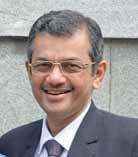
years ago, the UN laid out a compelling vision for the future. The global goals present a framework for a cleaner, fairer, more inclusive world for all. With the outbreak of Covid-19, momentum towards this vision has slowed considerably. The second wave of the pandemic has wreaked havoc and sent all aspects into a tailspin. And it has affected the younger age group. This has brought home the point ‘Prevention is better than cure’. I urge all Rotarians, clubs and districts to restrain from holding in-person meetings. Follow the Covid safety protocol and help in the fight against this deadly virus. I commend Rotary clubs, districts and Rotarians who have done tremendous service in spite of the challenges.
The greatest wealth and strength of any nation is its youth. Empowered youth can be a great force to drive a nation towards success and prosperity. To ensure a bright future for our country, we first need to strengthen and empower our youth. Today, India is one of the youngest nations in the world with more than 60 per cent of its population in the working age group. This is a big plus.
Developing countries with large youth population have the potential for tremendous growth, provided they invest in young people’s education, health and provide them with the right opportunities. Today’s youngsters are tomorrow’s innovators, builders and leaders. In Rotary we believe ‘Youth is like white paper; they reflect the impression you make on them’. Whether it is Rotaract, Interact, RYLA or RYPEN, Rotary’s focus on youth is to help them discover and fulfill their potential.
Rotary wants the youth not to lower their goals to the level of their abilities but instead to raise their abilities to the height of their goals. And so Rotary’s work with youth involves building leadership skills, learning, unlearning and relearning about the responsibilities that each of them have to himself and to others, and to imbibe values that could last a lifetime. The actions Rotary takes today for youth will help shape their lives tomorrow.
We all are merely temporary custodians of our wealth and resources. The best use of wealth is to share it with those less fortunate. Baatne se Badhta hain. All of us have sometime or other partaken the fruit from trees we did not plant. It is our time to give and we must plant trees and gardens whose fruits we may never eat, but which will benefit generations to come. This is our responsibility; this is our opportunity. Laying a strong foundation for Interact, Rotaract, indeed all youth will be the perfect way to fulfill our theme ‘Rotary opens opportunities’. Enjoy Rotary. Stay Safe, Stay Healthy, Stay Young.

Dr Bharat Pandya
RI Director, 2019–21
A brave, frank, clean-hearted, courageous and aspiring youth is the only foundation on which the future nation can be built
– Swami Vivekananda
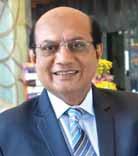
May is the Youth Service Month in Rotary. Youth service was officially added by RI as the fifth avenue of service in 2010 to recognise the positive change implemented by youth and young adults through leadership development activities, involvement in the community, international service projects, and exchange programmes that enrich and foster world peace and cultural understanding. Rotary clubs should be committed to involving youth and young adults in their vocational, community and international service projects, and provide programmes and resources that support them.
Youth service projects take many forms around the world. In every instance, Rotarians have an opportunity to be role models and mentors for the young people of their community. In Rotary, we are committed to encouraging young people to join our organisation and now Rotaract has also become a part of Rotary. As our youth grow to become adult leaders, it is hoped each will achieve that same desire and spirit to serve future generations. It is the responsibility of each Rotarian to prepare the next generation by improving their life skills to ensure a better future, while recognising the diversity of their needs.
Interact clubs give students opportunities to take initiatives, develop leadership and teamwork skills, community service ethics and international understanding. Through Rotary Youth Exchange, we hope to create a more interconnected and understanding world. RYLA helps young people learn new skills, build their confidence and have fun. New Generations Service Exchange is a short-term programme for university students and professionals below 30. Participants can design exchanges that combine their professional goals with a humanitarian project.
The outbreak of Covid-19 may alter the way we observe Youth Service Month this year. But it need not dampen our enthusiasm and spirit. Young people are looking for ways to make a difference. Show them how Rotary equips them to do so, especially in this time of crisis. Brainstorm sustainable service projects, ways to increase giving to The Rotary Foundation and build awareness of Rotary in your community. And watch your membership grow.
Take care and be safe.

Kamal Sanghvi RI Director, 2019–21
Board of Permanent Trustees & Executive Committee
PRIP Rajendra K Saboo RI Dist 3080
PRIP Kalyan Banerjee RI Dist 3060
RIPE Shekhar Mehta RI Dist 3291
PRID Panduranga Setty RI Dist 3190
PRID Sushil Gupta RI Dist 3011
PRID Ashok Mahajan RI Dist 3141
PRID P T Prabhakar RI Dist 3232
PRID Dr Manoj D Desai RI Dist 3060
PRID C Basker RI Dist 3000
TRF Trustee Gulam A Vahanvaty RI Dist 3141
RID Dr Bharat Pandya RI Dist 3141
RID Kamal Sanghvi RI Dist 3250
RIDE A S Venkatesh RI Dist 3232
RIDE Dr Mahesh Kotbagi RI Dist 3131
Executive Committee Members (2020–21)
DG Sanjiv Rai Mehra RI Dist 3011
Chair – Governors Council
DG Sudip Mukherjee RI Dist 3291
Secretary – Governors Council
DG Sangram Vishnu Patil RI Dist 3170
Secretary – Executive Committee
DG Prashant Harivallabh Jani RI Dist 3060
Treasurer – Executive Committee
DG S Muthupalaniappan RI Dist 3232
Member – Advisory Committee
ROTARY NEWS / ROTARY SAMACHAR Editor Rasheeda Bhagat
Senior Assistant Editor Jaishree Padmanabhan
ROTARY NEWS TRUST 3rd Floor, Dugar Towers, 34 Marshalls Road, Egmore Chennai 600 008, India. Phone : 044 42145666
e-mail: rotarynews@rosaonline.org Website: www.rotarynewsonline.org
Now share articles from rotarynewsonline.org on WhatsApp.
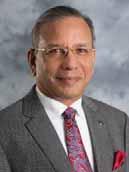
n the classic film Lawrence of Arabia, Peter
O’Toole plays T E Lawrence, the British scholar, military officer and author who helped Arab tribes in their struggle for independence against the Ottoman Empire.
Lawrence leads a group of Bedouin warriors through the desert for a surprise attack on the Ottoman port of Aqaba. As they reach the end of the desert, they discover that a soldier, Gasim, has fallen off his camel during the night. But it is morning, and the tribesmen led by Sherif Ali, played in the movie by Omar Sharif, advise Lawrence that going back to find him would be futile, that Gasim would already be dead given the sandstorms and the scorching heat. “Gasim’s time has come; it is written,” one of the soldiers tells Lawrence.
But Lawrence does go back and finds Gasim near death, staggering in the dunes. When they return to camp, Ali offers Lawrence water. Before taking a drink, Lawrence looks at him and says: “Nothing is written.”
This unforgettable scene means more than just a quotable movie line; it represents a way of looking at the world. It is a challenge to fatalism — that we must accept a certain outcome because of the way it has always been. No, Lawrence says, history is not written, yet.
So it is with The Rotary Foundation. We have not yet emerged from the sandstorm of the Covid-19 pandemic and the economic fallout from it. We are still occupied by work to raise awareness, deliver critical personal protective equipment, and provide support for frontline workers.
We do not know the day when, standing beside our polio eradication partners, we will announce that for the second time in history, a disease has been eradicated. We do know that, because we have worked steadfastly for years, the end of that story will be written soon.
And thanks to a $15.5 million contribution from the Otto & Fran Walter Foundation, we are also adding a new chapter in the story of our expansion of the Rotary Peace Centers: Plans are underway to launch a new peace certificate centre in the Middle East or North Africa.
Rotary is engaged in so many noble efforts; it is an ongoing story that inspires me even more than Lawrence of Arabia. We do not yet know the name of the baby whose life will be saved because of a maternal and child grant from Rotary, or the name of the girl who will learn to read with our support. When will those grants start, and will your district — or you — be directly involved?
Nothing is written. We write it.
K R Ravindran Foundation Trustee Chair
Rotary Club of Himalayan Ranges Mansa Devi, RID 3080, has been spreading smiles among hundreds of children every year since 2018 with their project Choti Khawaish (Little tastes). One hundred children are taken on a shopping spree every year and they are allowed to buy an item of their choice. “It could be a dress, toy, footwear, art material or anything. The radiance on their faces when they get to
hold their little gifts brings so much satisfaction to each one of us,” says PDG T K Ruby, a member of the club.
These children are drawn from orphanages or slum colonies and Rotaractors of RAC Chandigarh Himalayan (sponsored by the club) are given charge of three girls each to ensure safety. They engage the children and help them choose what they want from the shop.
This year the club took 130 girls from an

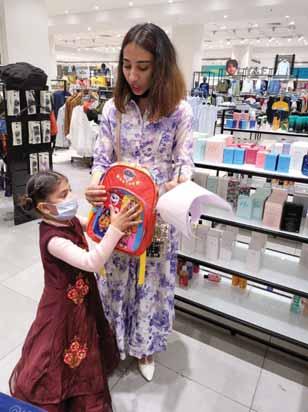
A Rotaractor helps a child choose a bag.
orphanage to the Elante Mall in Chandigarh. They were split into two batches across two days. Following a special request from the club, the mall was opened early and the children were treated to breakfast at McDonalds and lunch at Burger King.
“What is a given for our children and ourself is luxury for these children. But it was a joy to see them relish their pizzas, burgers and French fries. They were certainly delighted,” he smiles.
The Rotaractors had as much fun accompanying the girls on their shopping tour. Little Manasvi, all of six, was delighted to hug her “very own Barbie
doll”; while Amrita (12) twisted and twirled in a pretty pink gown. Some of them picked up bags, some others tried on footwear and few others were happy to pick up cosmetics too. Soon it was entertainment time, and the girls were treated to a movie — Wonder Woman — at the mall.
It all began when club president Gaurav Ghai visited an orphanage three years ago, recalls Ruby. His interaction with the children brought to light their simple wishes which “seemed a distant dream to them and we were sold to his idea.” Ghai sponsors a major portion of this project.
Rasheeda Bhagat
Iranians will restore your faith in humanity; I believe every single person should visit Iran at least once in their lifetime. In India we say atithi devo bhava; there is a similar adage in Persian which translates to ‘Guests are jewels from god, so you have to take care of them.’”
I listen fascinated to Naresh Kumar, all of 38, who has travelled across as many countries as his age, and who made waves at the Hamburg Convention by riding the 8,646km-distance from Chennai to Hamburg, traversing through 14 countries and two continents. He is a member of Rotary Club of Guindy, RID 3232. As he couldn’t get Pakistan visa, after being flagged off from Chennai, he had In Nepal, a stranger asked me if I wanted drugs, alcohol, or girls. ‘I can bring her to your room.’ It was like he was trying to sell you some goods, but it was a human life.

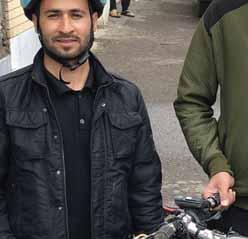
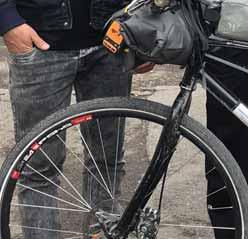
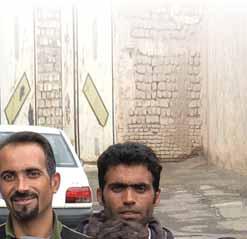


to fly, with his bicycle as luggage, from Mumbai to Oman, before hitting the roads again. He has done this quite often; “while other people are waiting for their suitcases at airports, I am fixing my cycle, so that I can hit the road straight from the airport,” he says.
That bicycle is a Tandem, which comes with two seats, and his present bike has been sponsored by somebody from New Zealand, a country close to his heart. But let’s get to his Hamburg Convention

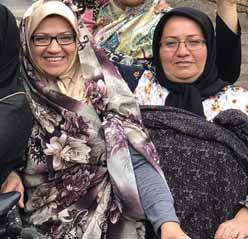
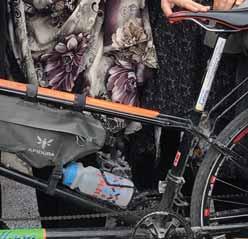
ride first. He set off on Feb 27, 2019, and landed in Hamburg in time for the convention, after 74 days. From Oman he went to Dubai, from where he took a ferry, “actually a container ship to go to Iran” and from Iran he cycled to Turkey, entering Europe from Istanbul.
It is with starry eyes that Naresh talks about Iran: “It took me some 18 days to cycle the 2,200km across Iran. Of these I spent 15 nights in random strangers’ homes.
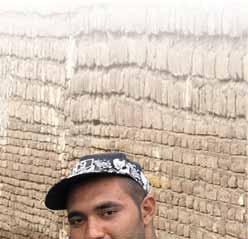
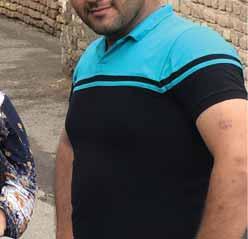
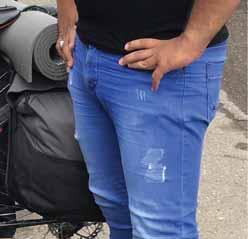
I am more an extreme endurance athlete; running, and not cycling, is my main sport. I ran 3,054km non-stop in New Zealand; I always push my limits to see what I am capable of.
When they see the second seat of the Tandem empty, and start talking, the first thing they say is come home.”
He uses Google translator on his phone to converse with people; in Iran it was English translated to Persian. “But thanks to the sanctions, my credit card or sim card did not work. I landed bang in the middle of the Navroz festivities and everything was closed. I didn’t know anyone, had no local currency, and it started pouring. I was sitting at a bus stop asking people how to go to Tehran… it was like asking someone in Chennai how to go to Delhi! From where he was at that point, Tehran was 1,800km away!”
A little boy, speaking broken English came from nowhere and invited him home, saying his family would love to meet him. He sat on the second seat, and they pedalled to his house. “I stayed with them for two days; they
The Iranian family who hosted Naresh Kumar pose with his Tandem cycle.
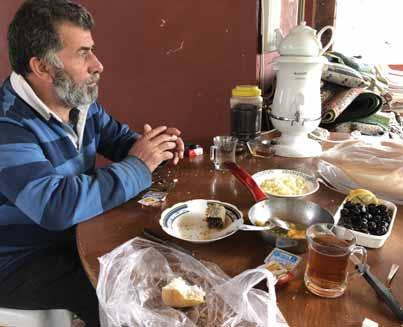
Hashe ever had a bad or negative experience, like being mugged or robbed, I ask Naresh Kumar. “Never, ever,” he says empathetically, adding, “my bicycle doesn’t even have a lock and it is lying on the side of the road when I sleep in my tent. Anybody can walk away with it; but nobody ever has!”
All that this Rotarian can recall are happy moments, good experiences and kind people. Kids jumping on to his bike, pedalling with him, and casually inviting him to their homes for dinner and rest at night. Or women in Iran putting together a sumptuous meal for him, inviting their friends over, so they can meet him, hear about his cause and get involved too, contributing whatever they can.
Turkey is another country of which Naresh speaks with
fondness, having travelled through it on way to Hamburg.
“I was on my way to Ankara and it was minus(-)10 degrees, and it started snowing, I was in the middle of nowhere in the night, and next, it started raining and I was standing under an abandoned building wondering how to reach the nearest village, some 15km away. A man came along in a jeep, saw the light on my bicycle, didn’t say anything, but communicated through sign language about going to his home for food and a bed.
I followed him on my cycle to his home, a modest single room. He gave me some Turkish food… cheese, bread, olives etc, put some blankets on a bench and made a bed for me.
The next morning, we shared a delicious breakfast!”
helped me get a local sim card, converted $50 into local currency and connected me to friends along the route to Tehran.”
When asked about how the idea of cycling to Hamburg came to him, Naresh says: “Actually I am more of an extreme endurance athlete; running, and not cycling, is my main sport. I ran a 3,054km along the Te Araroa trail in New Zealand

right from the top to the bottom in 2014, in the unsupported category. For me it has always been about pushing my limits, to see what I am capable of.”
He adds that solo and unsupported expeditions “force you to face the unknown. With grit and determination, you end up digging very deep within you and find something that you never thought existed. That is what brings out our best when things seem impossible.”
Coming from a very humble background in North Chennai… his mother never even went to school… against all expectations, Naresh graduated as an engineer in 2004 and got a job in an IT firm. “It was like you have no time for recreation; after three years he got an opportunity to go to the US. Meanwhile in Chennai he would run marathons (42.2km). But in US, he got more serious and started running ultramarathons,
The Mayor of Invercargill greets Naresh Kumar during his 3,300km run across New Zealand.
which are longer than 50km. “I also ran in the US a 500km race in Tennessee. It took six days; unlike those who participated in this run in the supported category and could have a car following them with their clothes, water and food, he had to carry everything in his backpack!”
Though it didn’t carry any prize money and Naresh admits that he did all this “more for the bragging rights”, there is a
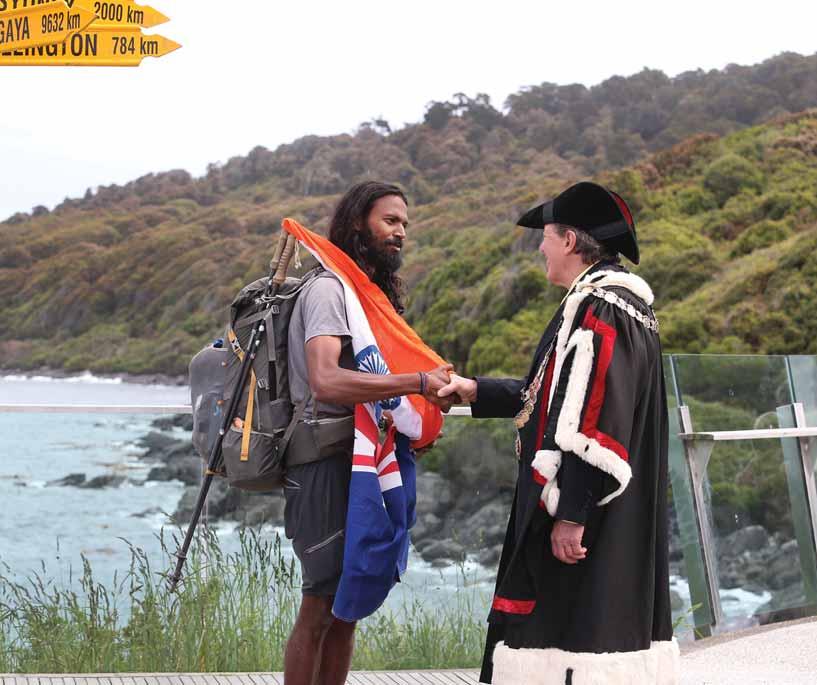
I say my journey is fuelled by kindness and peanut butter. I eat a lot of peanut butter!
serious underlying objective in these challenges he undertakes.
For the US ultramarathon, he was running to raise money to build wells in Africa to provide clean drinking water.
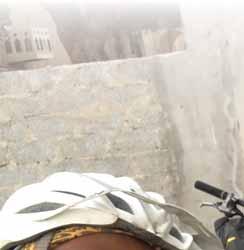
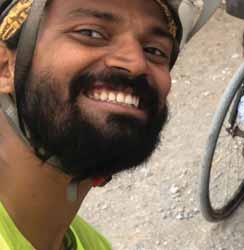
Rotary journey begins
All his adventures led to speaking engagements; at one such event several Rotarians were present, and they invited him to address Rotary clubs. The inevitable invite to join Rotary followed and he joined RC Guindy in 2019. While he takes up causes such as ending slavery and stopping trafficking of girls and women for sex, Rotary’s core objectives, such as eliminating polio, struck a chord with him.
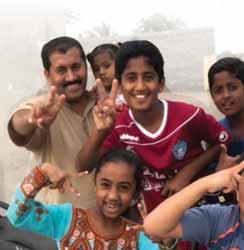
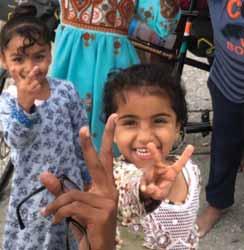
For the cause of rescuing girls and women from the brothels in Thailand, Cambodia and parts of Kolkata, he undertook the mission to ride a distance of 3,300km across New Zealand. “Initially people laughed at me saying who will join you. Well, 140 people did join me in that adventure and against my goal of raising NZ $20,000 (New Zealand) we raised a total of $50,000!”
He has of course quit a regular job and does freelance work. Ask him where he finds the money to
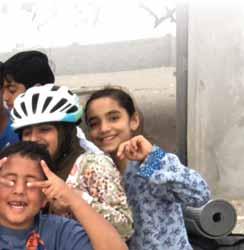




Naresh Kumar’s adventures include riding across Australia, where he participated in the Indian Pacific Wheel Race, “representing both India and New Zealand in this 5,800km-race from Perth to Sydney”. It was during this ride in Australia that he got a call from a Chennai Rotarian called Rajamani, who asked him that at the Hamburg Convention, one of the major sessions would be on ending polio. “As your mission is to end slavery, why don’t you cycle from India to Hamburg and we can promote your cause to “end slavery now”.”
He agreed, and before the ride, joined Rotary too. He started planning for the over 8,000km-ride from November 2018, and “besides training for the event, I had to also deal with the bureaucracy, getting visas, for so many countries, etc.”
For him, the 30km-End Polio Now cycle rally was a cakewalk. That event finished at a stadium where there was a meeting and he was introduced by a woman. “She asked the participants: ‘How many of you got tired cycling 30km and so many people said, yes it was a pretty hot day. And she said:
‘Well, here we have a gentleman who has cycled 8,646km all the way from India!”
His girlfriend, who is very supportive about his mission, also came for the convention and they met in Berlin and cycled to Hamburg.
With a chuckle he recalls a blacktie event where he was invited…. “here was everybody in suits and I was wearing a tee shirt. I had only two pairs of clothes!”
But the 74-day journey was not all smooth sailing. “I was going through temperatures which were from minus(-) 30 to 44 degrees Celsius. I got extremely sick in Prague, lost a lot of weight and was riding with a temperature of 104 degrees F.”
Finally in Vienna, he was so sick that he couldn’t even get up and had to see a doctor. “Medical care is so expensive there and something I couldn’t afford. But I needed some medication. This doctor gave me an emergency appointment, prescribed medicine and when I asked about his fees, gave me a tight hug and said: ‘Your expedition is as good as mine and I want you to succeed. If you really want to pay me back, just send me a picture of your safe arrival in Germany. That will give me happiness.”
Not only was he spared a 100–150-euro fee, the nurse too gave him a hug, free medicines and introduced him to her friends, who donated 50 to 100 euros for his cause. “We raised about `12–15 lakh for ending crossborder slavery in India.”
travel so much and he laughs, “I don’t; that’s why I travel by bicycle, get a tiny bit of sponsorship where someone pays for my airfare. I carry a tent and sleeping bag on my bicycle and never ever stay in hotels. My cycle is called Kindness and seeing the
back seat empty, out of curiosity people pull up to ask whether my girlfriend left me or we had a fight and then I tell them my story, the cause and invite them to take that seat and join the cause.” He always carries an extra helmet. “I’d say my journey is fuelled by
kindness and peanut butter. I eat a lot of peanut butter.”
Anyone can join him and they do; couples travelling in a car stop, first the woman takes the rear seat on his cycle, the man follows in the car and then they switch seats, while they hear Naresh’s
I also ran in the US a 500km race in Tennessee. It took six days, and I did that to raise money to build wells in Africa to provide clean drinking water.
fascinating story. “All across New Zealand, not a single day have I stayed in a hotel; when I pitch a tent on the side of the road for the night, random strangers take me home and offer me a bed and hot food!” Also, he clarifies, “I run in sandals, and once broke my foot while running a 300km-marathon and continued running with a broken foot.”
In New Zealand, he became quite popular and did a lot of public speaking. At one such event, the MC was Jacinda Ardern’s partner, before she became prime minister, “and even though I have never met her, she knows me and he has become my good friend.”
His bike is fitted with a GPS and it is connected to his website. “It’s like Uber… you can track the route. I tell my parents and friends if the green dot is moving, I am fine. If it doesn’t move for 24 hours and there is no green

check — which I always ensure as my parents get worried when they read about a bomb blast in Iran when I am there — then you can worry! My parents are the biggest supporters.”
Once in Nepal, a man tried to sell him a young girl for sex. “On the street he just asked me what do you want; drugs, alcohol… I can also supply girls. I will bring her to your hotel. It was like a stranger trying to sell you some goods, but here he was trying to sell a human life, and so casually. Hence came my motivation to work against human trafficking. It is unbelievable, but there are 40 million people in bonded labour and sex trafficking and slavery around the world and 80 per cent of them are women and children who are the most vulnerable,” he says.
Once he took up these causes, he decided to have two seats on his bike.
“Riding one seat is easy;
I carry a lot of Indian spices with me. There is nothing like sharing your traditional culture in the form of food.
it’ll be much lighter. Getting somebody to open his wallet is easy; after all, who doesn’t want to help prevent children getting raped? They will give some money. But I want them to also become advocates so I tell them I am very tired, I need your help. Can you join this cause, take a seat and ride with me, and no one says no!”
So how long do they ride with him; “anywhere from 100m to 80km,” he says.
About the future, once the Covid pandemic is behind us, Naresh, in collaboration with RAGAS, a Rotary action group against slavery, will undertake a 6,000km ride across the US. It is called Freedom Seat USA.
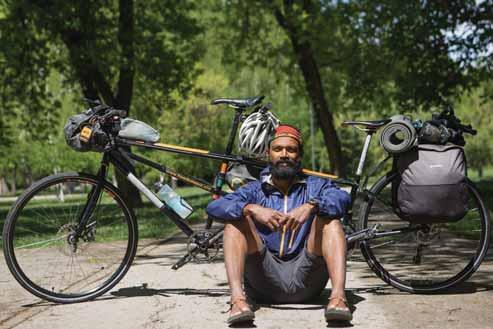
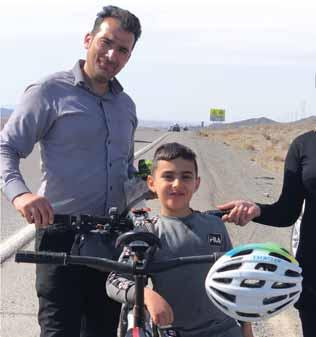
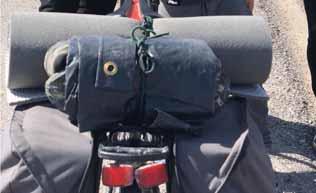

“I will first dip my wheel in the Pacific Ocean and then ride to the Atlantic Ocean.” It was supposed to start in April 2020; “my flight was on March 25, and the country shut down on March 23!”
His dream for the future is to give back to society, “and to do that, you don’t need much. It cost me less than `1 lakh to go from Chennai to Hamburg.”
He’s happy to share that everywhere people love and respect India. “I am never alone, and always surrounded by people. I carry a lot of Indian spices with me, and in some places, while they cook for me, I take over the kitchen and cook for them.
I tell them all I need is any meat, marinated in yoghurt. There is nothing like sharing your traditional culture in the form of food.”
So once in Spain, while a family was making Paella (a Spanish rice dish) for him, “I was cooking butter chicken! They loved it, we ate a good meal and I ended up staying five days with them!”
More at www.freedomseat.org https://www.freedomseat.org/film
Designed by Krishnapratheesh S
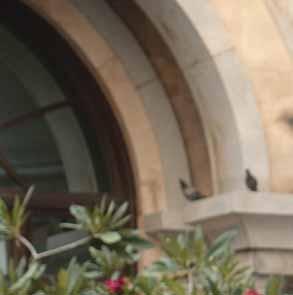
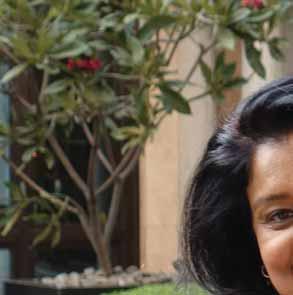

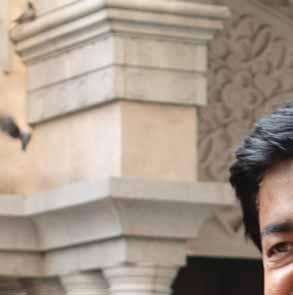
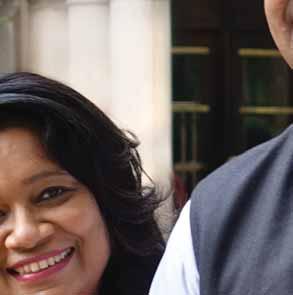
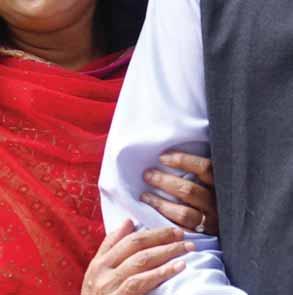

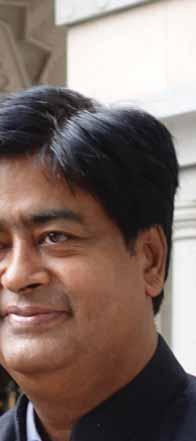



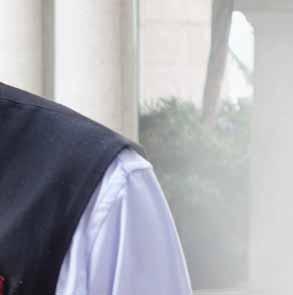




that doesn’t need marketing
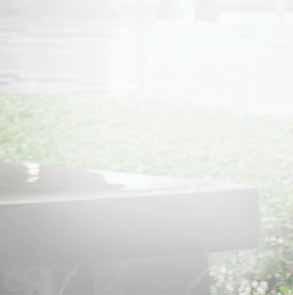



You want to hide under the chair when RI Director Elect A S Venkatesh says casually about solving Sudoku puzzles, his favourite pursuit apart from playing bridge. When his wife Vinita says “he is doing Sudoku all the time”, he responds: “But after a point, even the extremely difficult ones you do in 2 or 2.5 minutes. Then how do you challenge yourself,
and you always need to challenge yourself, so I give it a break for some time, and start afresh.”
Mulling over the kind of grey matter nestling inside his brain, while comparing the time I take to solve even the ‘middle’ category, I keep a straight face.
chose IIT Madras as I lived here.” The same choice was his for an IIM, after his B Tech (1985); he got offers from all the three, but obviously chose IIM Ahmedabad.
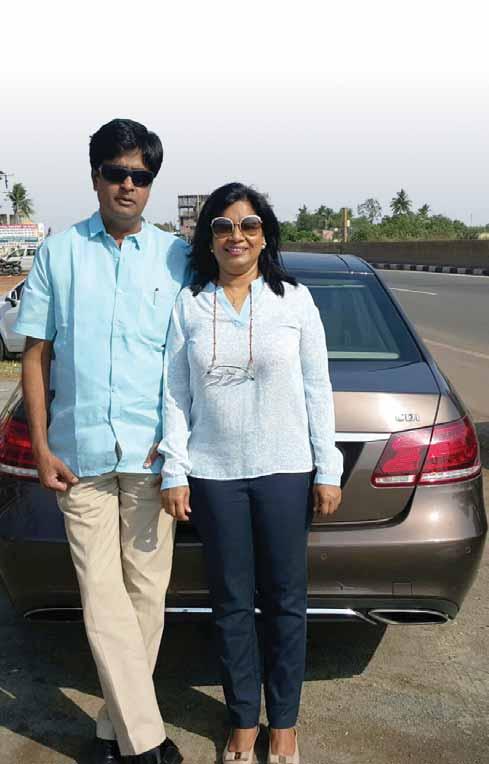
Born and brought up in Chennai, Venkatesh’s brilliance was evident when he applied for IIT admission and “could have chosen any IIT, but
Asked why a management course after a coveted IIT degree, Venkatesh says, “I wanted to be an entrepreneur and not work for anybody. I saw myself not as a pure engineer but an entrepreneur, which required managerial skills. And I lacked finance and accounting skills, hence an MBA. But I returned from IIM Ahmedabad (1987) with more than an MBA!
The reference is to Vinita, who is more vocal about why she fell head over heels in love with him. “He was tall, dark and handsome and brilliant to boot. I knew that my mother will love the tall, dark and handsome bit and my father would love that he is so intelligent and a class topper.”
In less than 15 months they were married in 1988; “it was more like a child marriage, I was just 23,” he smiles. They have two daughters; the elder one Varsha did her computer science degree in the US and is now working for Netflix there. Varuna, the younger one, who pursued her higher education in the UK, is also a software professional and now works in Manchester, UK.
Venkatesh’s foray into Rotary is interesting; with no family member in Rotary, he knew nothing about it. But being in the construction business, he was dealing “all the time with workers, and there came a time I thought I might even forget how to speak English.” With an architect friend inviting him to join Rotary saying he would meet like-minded people, he joined RC Chennai
Religion: I believe in god; I may not go to a temple for months together but I am a strong believer.
Food and favourite cuisine. Oh, I’m a big foodie. My favourite cuisine is of course Tamil cuisine, because that’s what I have grown up with. I eat everything and love to experiment, particularly with local food wherever I go.
Cooking: Not much. Vinita is a very good cook, but her skills are not best utilised in the kitchen, though. (Vinita adds: There was a period long back when I was cooking every day. One day he sat me down and said what are you doing. You are out working the whole day, and in the evening when you are back home, all your time is spent in the kitchen, neither I nor the kids get to see you. Please get a cook!)
Music: I like fast beat music — it energises me. Whatever be the language it doesn’t matter… Indian, Western, fusion, but with a catchy rhythm.
Movies: I used to enjoy movies once upon a time
but haven’t watched a movie in a long time. I have lost interest. I like comedy. If you ask me to choose a movie, I would choose a comedy. Again, language doesn’t matter.
Reading: I like biographies… if you come to my office you will find biographies from across the world.
Favourite writer: I read Lee Iacocca’s biography, and Akio Morita’s Made in Japan in the formative years of my career and they have left a deep impression on me.
Bridge: I am a serious bridge player. At one point, I represented Tamil Nadu and was the president of the Tamil Nadu Bridge Association.
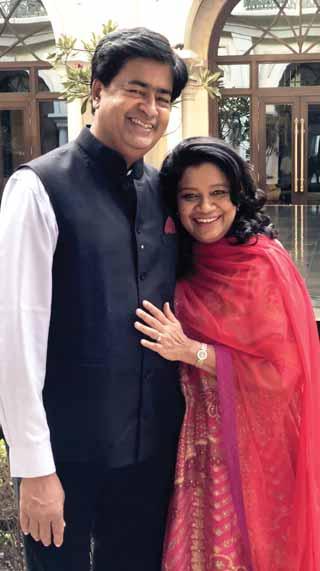
Venkatesh has never pushed any of us into doing anything, but listening to him was inspiring and I felt the pull to become a Rotarian. Vinita Venkatesh
Travel: Both of us love to travel to parts of Europe, be it Greece, Switzerland or other European countries. I like Asian countries too. We must have travelled to 50 to 60 countries but we both love Europe.
Relaxing: I love to play bridge and I enjoy trekking.
Fitness: I work out on most days, sometimes on the treadmill at home, other days walking or jogging.
Dream: Personal dream — simply to be happy and healthy. The journey may be different but the destination is that! I am a man of few needs so money is in no way a motivator — new life experiences are! That’s my philosophy. Coming to Rotary, our region is doing great — I am proud of our Rotary work, but there is huge unharnessed potential for membership growth, which we’re not really addressing.
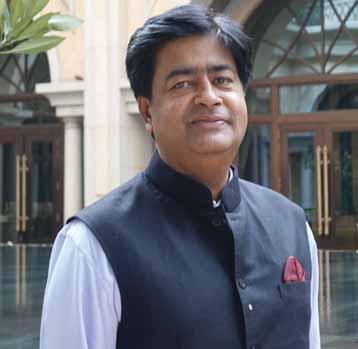
Leadership: It’s a process of evolution… you handle responsibilities and as you discharge those responsibilities and get feedback from people on how you have performed, then comes the realisation that you can contribute, your contribution is good. An image is formed, even among your seniors, that this is somebody who will work hard and deliver.
Importance of training in Rotary: Very important. All those who are in Rotary are already very successful in their own vocations but very few know what to do in Rotary and how to do it. They have the potential and skills to succeed, provided they channelise those skills, and that is where training comes in. There is random talent all over the place; it has to be spotted,
and channelised. Fortunately, that is what is happening in Rotary.
Values that have shaped his life: I can say with full confidence, I have never tolerated corruption in my business. And I am in a business like construction! For this reason I’ve turned down assignments and projects. I get good sleep at night and enough business to keep me going and happy. Is it all I can do? No, I can do more. But do I want to do it? No I don’t, because doing ethical business is something I hold very close to my heart and will not compromise on it. Another core life value is that I never look back and regret anything… I learn my lesson and just move on.
Recognising talent: I believe everybody has a talent. If one
can understand, appreciate and spot that talent and make them contribute, we can get the best from everyone. Somebody’s skill may be different from mine, that doesn’t mean he is better or worse. We should use him for that skill. As a leader if I can open my eyes and recognise that everybody has some talent, then I can put her in my committee. Several of my committees have members who are much better than I in certain things and I am happy to have them. They are not competing but complementing my skills.
Increasing women’s membership: Again it goes back to the club. People don’t join RI, they join a club. When Vinita joined Rotary, she didn’t join my club. Why did I suggest another club? Because I felt she would be comfortable there as it had women members. The culture should be such that the club members should be welcoming of women and make them feel comfortable. I encourage every governor to include women in committees, give them leadership roles. That will inspire other women to join. Coming to all women’s clubs, which we see in India, it is better than not having women members. But that may not be the best way to go about getting more women into leadership positions, and for two reasons. It is still a single gender club, and as bad as a man’s club. And it is a disservice to women themselves, because in a club of 40, only one woman can become a president in a year. But if the same 40 women were in eight different clubs then five can aspire every year to be president first and then contest for governor’s post. That is how you generate women’s leadership.
We should reach a stage where people choose Rotary and say I want to join it. We should be able to pull them into Rotary rather than push Rotary into the community.
Mambalam in 1998. Not in his wildest dreams did he think he would rise to this level in Rotary, he smiles. But it took the newly-minted Rotarian a while to really engage with Rotary, even though he had a “cent per cent attendance, having been warned that without that I’d be thrown out.” But by the second year he was a part of some club committees and in the fourth year became the club president. From here to the DG’s post was quick too; “I remained a past president only for 30 months,
and in the third year of my being president, I was a DGN,” he quips. The highlights of his year as DG (2007–08) were the official visits which he really enjoyed, getting to meet so many Rotarians, starting the 100th club in the district, and taking its TRF contribution to the highest ever at $600,000. Till then, J B Kamdar, the previous DG, had set a record of $500,000. “But honestly, I did not push anyone to contribute, though I spoke a lot about the work the Foundation does. And the contributions came in.”
Giving the “perspective of one who sat in the audience at his Rotary meetings”, Vinita says Venky presented a fresh perspective of giving to Rotary — that Rotarians of developed countries had given money to TRF year after year, not a single penny of which went to them, but

was channelled to developing countries like India to fund the End-Polio and other projects. “He’d urge: ‘Don’t you think we should also give back, so others less fortunate than us can benefit’, and that seemed to touch a chord.”
So as a spouse, did she resent Rotary taking away so much of his time? “On the contrary, because I was very busy with my career (shipping), I never was at a loose end when he was away. In fact, I was proud and happy that my husband
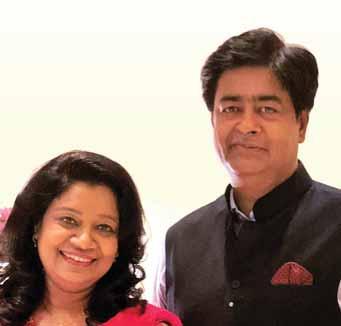



was involved in an organisation with such lofty goals.” Moreover, inspired by his passion and involvement in Rotary, 10 years ago, when she took a break in her career, “I also wanted to be part of the Rotary experience, as Rotary was a constant topic at home and it was inspiring to listen to Venky describing Rotary’s work. He has never pushed any of us into doing anything, but I felt the pull and also wanted to be associated with Rotary.”
She joined a different club, RC Chennai Towers — “because his club did not have any women, and
we felt I’d be more comfortable in a club with women members.”
When I ask Venkatesh when the idea of becoming an RI director came to him, he grins and says: “I had never even planned to become a club president in the first place. In 2001, the president-elect unfortunately had some business challenges and pulled out after attending PETS. My club members said you will be the next president and I didn’t object.”
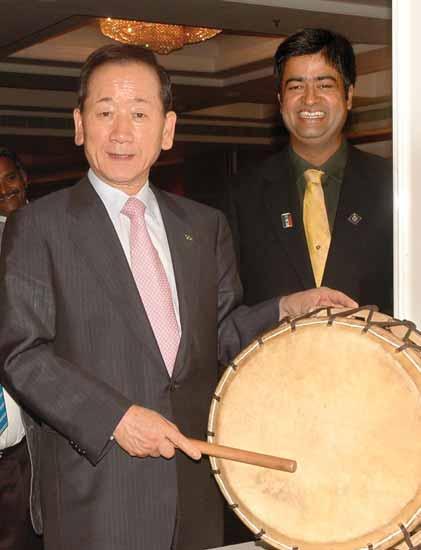
But, as Vinita intervenes to say, leadership qualities were always a cornerstone of Venkatesh’s personality. He was school captain, in IIT Madras had fought an election to be hostel affairs secretary and at IIM he was the general secretary of the student union. Adds Venkatesh, on his present position, “I believe the opportunity evolved through carrying out the assignments that were given to me over the years.”
The incoming director has also made a mark in Rotary as a training leader at the International Assembly in 2016, an assignment repeated, rather unusually, the next
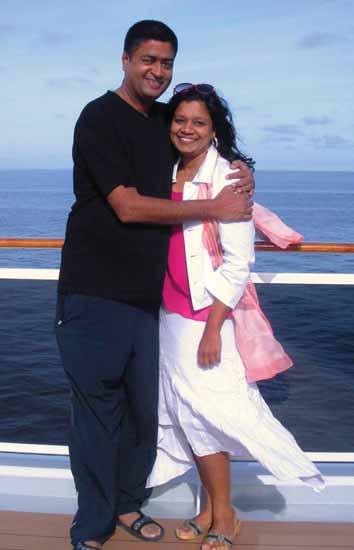
year. “Prior to that I trained Rotary coordinators from across the world at Evanston. In 2017 RI President Ian Riseley invited me to train the trainers. That was a great opportunity.”
On the priorities during his year as director, Venkatesh says, “We have to ensure that Rotary becomes an organisation of choice for people to join. Right now we are marketing it. We should reach a stage where people choose Rotary and aspire to
She has played a very important role both in my career and Rotary. In Rotary, a major problem is that you will never get true feedback for anything. Everybody, even if you mess up something totally, will say you’ve done a great job. But for me, the way she tells me when I mess up, is very important. It is not just critique, but finding the right time to tell me. She has the uncanny ability to know the exact time when I will accept objective and critical feedback. Very
With his daughter Varsha’s pet cat Vodka.
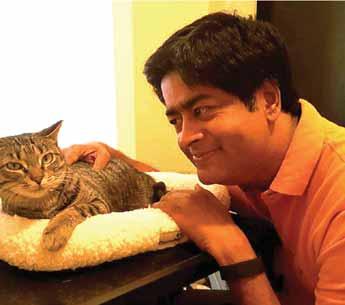

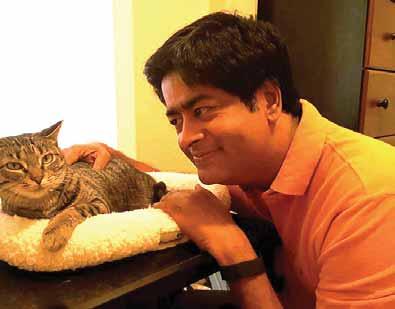
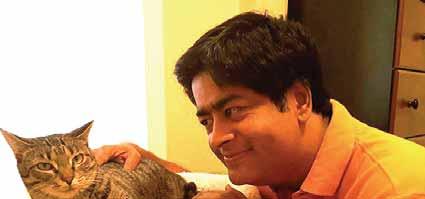
often, after I’ve come home after finishing an important programme, I am floating because everybody has said what a great job you’ve done. She won’t say anything then.
A few hours later she will suggest what I could have done differently.
Apart from other things she has played that very important role. And she has been absolutely supportive. Right from 2010 I have been missing from home every Sunday because of Rotary and she has never complained. But then she is also busy and travels a lot on work.
join it. We should be able to pull them into Rotary rather than push Rotary into the community.”
A few things are required for this. “The size of the projects we do should be so impactful that they are totally visible. Or if we get a huge recognition, a Nobel prize for instance. I dream of the day when anybody who wants to volunteer choose to join Rotary.”
As far as zones 4, 5, 6 and 7 are concerned, “in our region, we’re doing phenomenally
well on projects, and are among the best in the world for community projects. But we still need to do a lot of work on sustainable membership growth.
Growth we have, but we need to make it sustainable.” His analysis shows that “in a 7–8 year period we lose as many members as we add. Had we not lost anybody we would have doubled in eight years. This is something we are not yet addressing. My priority will be to ensure every
Our region is doing phenomenally well on community projects, but we still need to do a lot of work on sustainable membership growth.
This whole emphasis on ethics, about which you were asking Venkatesh, and the way Rotary has influenced our lives… because of him our entire family has been impacted by the principles of Rotary. A small

district realises what is happening on the membership retainment front and addresses the issue.”
So why do people leave, I ask him. “Because of inadequate orientation when they are inducted. In a lighter vein, let me add that I’ve heard that when asked to join a club, some people have asked, does it have a swimming pool? So training at induction is very important.”
Laying emphasis on strengthening the clubs, he adds: “Everything happens at the club. Members join a club,
example; as the corona pandemic started, we were very anxious about our daughters’ safety and whether they have enough provisions. In the UK, our daughter Varuna was going out every week to buy provisions and anxious about her safety, I suggested that she buy a month’s supply. She responded that if I do that I will be denying somebody else who needs that particular item, because in the beginning of the pandemic there were shortages. I was so taken aback by the concern He was tall, dark and handsome and brilliant to boot. I knew my mother will love the tall, dark and handsome bit and my father would love that he is so intelligent and a class topper.
Vinita Venkatesh
she exhibited for the community at the expense of her own safety and comfort. These are the principles they have imbibed from him. He is not a preacher — never will he say do this or don’t do that but he has taught them much more by his own example.
So as a spouse how does she feel about his Rotary achievements? “Oh, I am infinitely more ambitious for him than he is… in both Rotary and beyond — because I truly believe that he has what it takes. In Rotary, I believe, posts or positions are opportunities to serve and those opportunities are god given. There are so many people who work so hard and aspire for so many things in life. But unless you have that one blessing from the Almighty, it doesn’t happen. We are very fortunate that he has reached this position and got the opportunity to serve, and he does his best.”
So is he very hardworking? “He is very smart working. What any of us would take 10 hours to do, he has it done in one hour… so if he works for all the 10 hours, his productivity is much higher. And I don’t say it because I am his wife. I am of course incredibly proud of him, but you will hear this from everybody who he interacts with, including his parents.”
projects are done by the club; there are no two ways about it.”
A great votary of doing everything “the scientific way”, he says, “When I was an RC for a three-year term (2010–13), before (PRID) C Basker, my analysis showed the interesting fact that about 80–85 per cent of people who left Rotary had not even contributed a single dollar to TRF. “If one contributes even $100, he has a sense of ownership and will bother to find out what has happened to his money, how it is being spent. He becomes a stakeholder. So
I tell club presidents, make everybody contribute at least $100, and your membership will sustain.”
His constant refrain is that this may be a voluntary body “but that does not mean it should be run amateurishly! A voluntary body can be professionally run. Professionalism is not only for our business, let us extend it to Rotary. All of us are capable and do it competently in our professions, but when we come to Rotary we switch off that button. My constant refrain is let’s apply our professional skills to Rotary,” he says.
Physical meetings:
I quiz him next on the exciting part of his year as DG being actually meeting

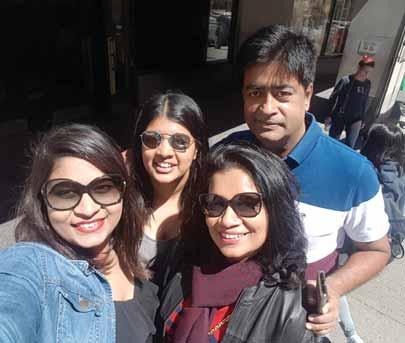
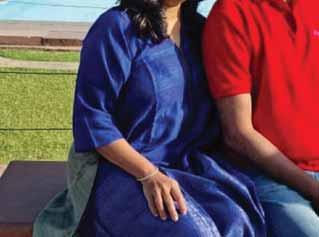

people, an important hallmark of Rotary. Does he miss it terribly during the pandemic? “Yes, that is a big challenge and we all hope we will soon get back to it. It is a very important component of Rotary’s survival.” He believes that “Paul Harris found the best marketing formula. Human nature needs two things, one is to feel good about yourself which is what you get when he you do charity. The second is socialising. He founded an organisation which addresses both these needs. It is the best marketing formula which one can find and will never go out of fashion.”
On busy professionals like him volunteering so much time for Rotary, Venkatesh says: “It is often said that somebody who is busy will have the time for everything. In fact as Bill Gates once said: ‘I’ll find the laziest man to do the job because he will find the quickest way to do it!’”
Pictures by Rasheeda Bhagat and K Viswanathan
Designed by Krishnapratheesh S
Twenty-five villages and 25,000 habitants are the beneficiaries of a resurrected pond in Kulaith, a reserve forest 25km from Gwalior. The pond was brought to life by Rotary Club of Gwalior, RID 3053, through a global grant project with TRF, RC Omaha, RID 5650, USA, and RC Nagpur,
RID 3030. Gwalior Alcobrews extended major support as part of its CSR endeavour.
“When we first saw it two years ago the waterbody was in such a pathetic condition — it was filled with silt, and the boundary walls were broken. It simply was in no condition to gather rainwater. The place was an abandoned site infested
with anti-social activities,” said project coordinator Prabhat Bhargava, an architect. The club conceived a global grant project to rejuvenate the waterbody.
Work began after taking requisite permission from the local administration and forest department. The pond was desilted, excavation was carried out with
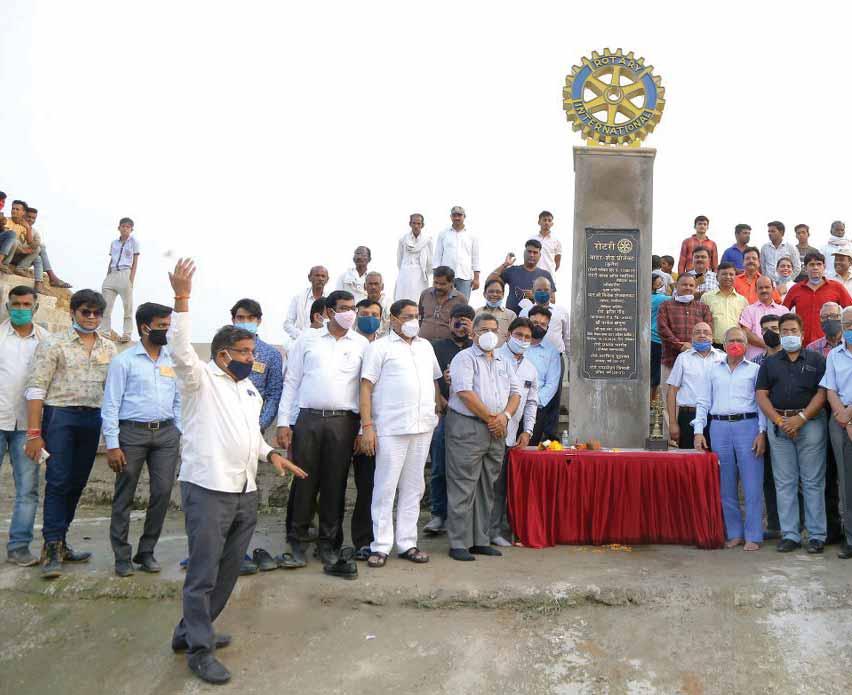
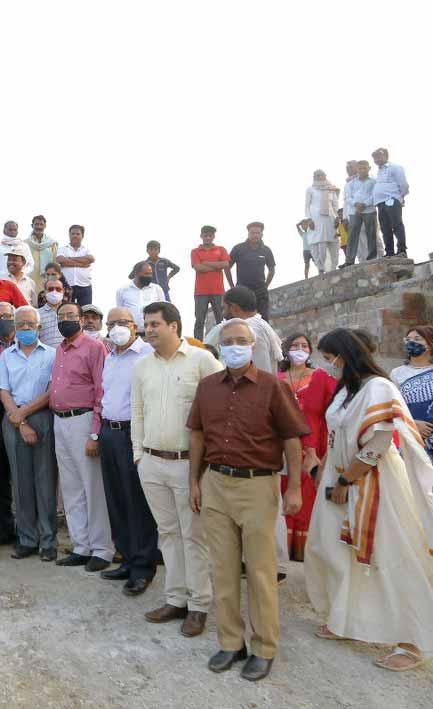
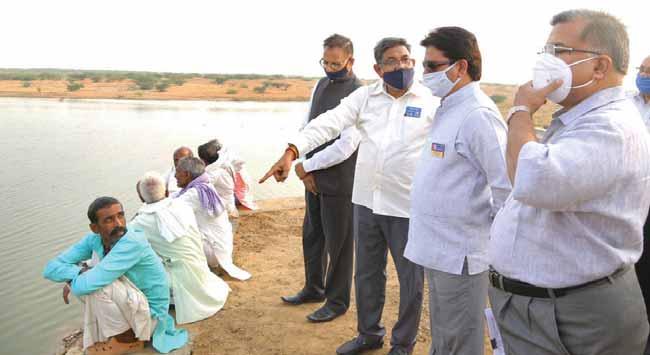
tractors and the excavated earth was used to build the boundary walls and bunds. The area surrounding the pond was beautified with plants and a garden. A pillar with Rotary Wheel now adorns the garden. Over 200 saplings of 60 species have been planted in the region. Around 10,000 fish were also purchased and left to breed in the pond.
The restoration exercise raised awareness about water conservation among the villagers and they are happy to be able to grow more crops as abundant water is available now, said Bhargava. The pond can now store 30,000 cubic metres of water. Facilities have been made to direct the flow of excess water from the pond to nearby canals during monsoon season.
Even as the project was nearing completion, there was good rainfall and the pond got filled up significantly, said DG Harish Kumar Gaur who inaugurated the project two months ago.
“The whole area has now become beautiful. Now we find hundreds of birds visiting the area. The water source will help satiate the thirst of wild animals in the reserve forest and also help villagers irrigate their lands and maintain the cattle.”
The district has set up 35 Covid care centres. RC Bhiwadi, his home club, has recently established three Covid vaccine centres and is donating a TB screening van to the government next month. “This year we have created 40 Happy Schools with CSR support,” Gaur added.
Rasheeda Bhagat
Adecade ago, I completed one of the greatest achievements of my life.
My husband Nick and I climbed nearly 20,000ft to reach the top of Mount Kilimanjaro in Tanzania. It was part of a personal challenge as well as a Rotary fundraiser,” said RIPN Jennifer Jones, addressing the zone institute titled

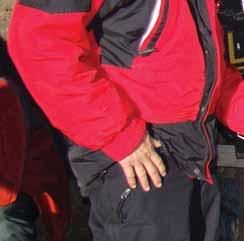
The Odyssey . It took their group five days to reach the summit; “the first day in lush forest, the second in a thick brush, the third in low scrub and the fourth day was like landing on the moon… there were craters all around and no sign of life.”
Keeping her virtual audience spellbound through her gripping story, she added that climbing Kilimanjaro is not a “technical climb like climbing Everest. The battle with Kili is the

altitude and for me it was a journey to the depths of positive thinking.” By the time her group arrived at the base camp, above 15,000ft, two of the team members were exhibiting mild to medium signs of altitude sickness. “It begged the question: Should we really be doing this?”
The summit is attempted at midnight and takes between 6–7 hours. This time is chosen because the temperature drops to minus (-)20
RIPN Jennifer Jones holding a Rotary banner and her husband Nick Krayacich holding a copy of The Rotarian at the Gillman’s Point before reaching the summit of Mount Kilimanjaro.

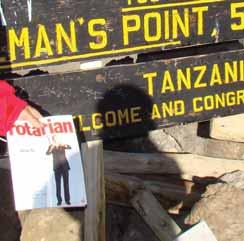
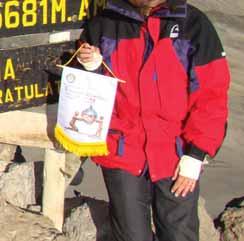


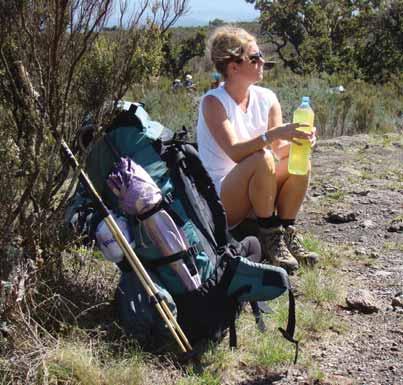
degrees C, “freezing the ground so you can get better traction. Each group attempting the climb is led by a group of guides, and this is a coveted job because of the great tips they receive.”
Making her story personal, Jones added that as they set off that night with a torch on their heads, “I was torn by whether to feel exhilarated by the opportunity or terrified that something could go wrong.”
Fortunately, only after reaching the ground level they’d learn that a guide from another team had died that night. And a 22-year-old English man had suffered a cardiac arrest.
“While we climbed, our guides were singing Christmas songs in Swahili and the rhythm of the music created a pace to our steps. The mantra of the climb was polepole (pronounced
poleypoley) in Swahili, which means ‘go slow’.”
Altitude sickness is warded off by staying well-hydrated and taking time to adjust to each level by going very slowly. She confessed that she had taken this expedition “a little too lightly and without full appreciation of the dangers involved. I knew them but was most excited by the adventure and was very eager to reach the top of the African continent.”
When it seemed to the team that “we had been climbing forever”, their guide shared that they had done only a quarter of the way to the top. “At this point our water, even though insulated, was frozen. It took everything in my being to stay focused and put one foot in front of the other, even while asking myself why was I there. I had to dig really deep inside to stay positive.”
She confessed that she was ready to throw in the towel countless times. But to what end? There was no easy way out. That last hour was the most
The last hour was the most
difficult and required a lot of rock climbing. “And it was just as the sun was peeking above the horizon that we reached the top. The sky transitioned from a thick carpet of stars to an orange tapestry of colour.”
Jones told the incoming governors and DGNs that she was sharing this story about climbing great heights with them because Rotary too provided the opportunity to reach various summits or leadership positions. “And when we do that, shouldn’t we be shouting about it from the top of every mountain? I urge you to tell the stories in yours clubs and districts about what helped bring Rotary to life as a global network of professional and business volunteers. Rotary is a brand that unites the world, we simply have to climb the mountain and shout just a little bit louder.”
A PR and communication specialist by profession, Jones said that the clubs that have “good PR are the ones that are growing. PR is the best tool for our membership, both for induction and
retention. When we tell our stories in Rotary, like-minded people will want to join, and it helps if they know who we are and what we are doing. And a sense of pride is created in our ranks. Telling your Rotary story is a great way to keep our members engaged.”
She said there was a time “when we did service quietly; only from the past decade it has been one of our key strategies to tell our stories publicly so that likeminded people want to join us. Each and every one of us has an amazing Rotary moment. But it has to
PR are the ones that are


be taken to the next step and the way we have changed people’s lives has to be shared.”
She added that a few years ago, while visiting Chicago she went to a shop looking for “a gratitude journal, which was the trend then.” One wrote here all the positive things that

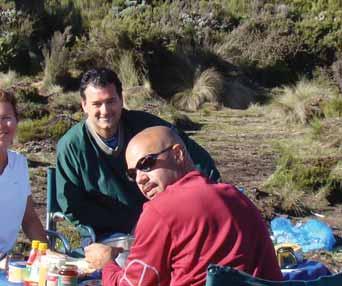
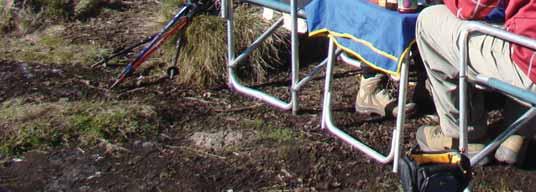
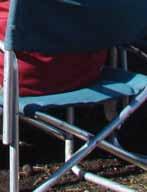

happened to them; “I found my book, and told my brother, who was with me, that this was going to be my gratitude journal.” When she went to the checkout counter, the clerk wrapped it up with great care, even putting a pretty ribbon on it. He told her that he had overheard her, and requested: “I want you to make me your first entry in your gratitude journal.”
Jones added that because of the Covid pandemic, both the world and Rotary had been “changed in ways nobody could have foreseen. Covid-19 has changed the way we meet, socialise
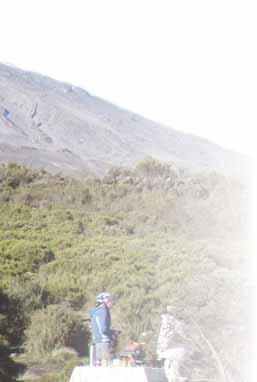
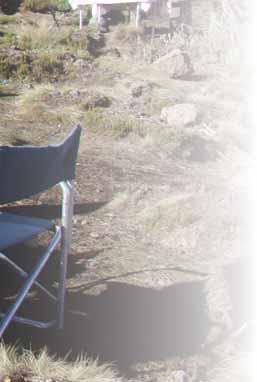
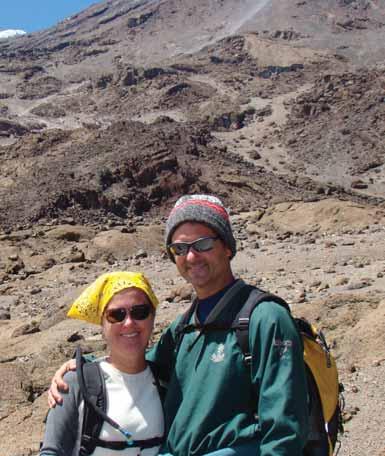
and even celebrate. With vaccination beginning, and more challenging times ahead, the world needs us more than ever, so we need to remain connected.”
The DGEs and DGNs had been given great leadership positions, which would give them immense opportunities.
Quoting the great feminist writer Maya Angelou, she said: “People
There was a time when we did
will forget what you said, people will forget what you did, but people will never forget how you made them feel.” They would do well to remember these words while dealing with their district members and their families.
Jones elaborated to the district leaders how to share their personal Rotary stories. “Paint it with your words, put forth the human face, making the emotional connection. Your lives are rich with content. And you can connect with Rotarians and beyond. Imagine if we could engage our 1.2 million members as greatest storytellers. Everything we do as Rotarians affects our image and brand. Telling our stories in a compelling way affects the way our organisation is perceived. So do go out and tell your stories.”
Pictures courtesy: RIPN Jennifer Jones
Designed by N Krishnamurthy
In the next five years the GoI is planning to build 100,000 check dams across India. And we have committed to undertake 10 per cent of the work — 10,000 check dams over six years. That is, 1,600 check dams a year. It is doable if all Rotary clubs come together. It will be 40 check dams for each of the 40 districts. The cost will be equivalent to only two global grants when you calculate at `300,000 a check dam. We have the experience and we can do it.”
With these words RIPE Shekhar Mehta encouraged around 200 delegates at a virtual WASH seminar conceptualised by PDG Ramesh Aggarwal, member, TRF WASH Major Gifts Initiative Committee.
In line with the government’s plan to provide tap water to every house in the next three years. “we have agreed to take it to at least 1,000 villages or 50,000 houses,” he added. Rejuvenation of water bodies, providing rainwater harvesting facilities and constructing public and household toilets are also part of Rotary’s WASH plans. “Our participation should be such that Rotary should be considered as one of the foremost players for WASH projects across the country and the world,” said the incoming RI president.
TRF Trustee Gulam Vahanvaty gave an overview of TRF’s impact over the years and requested Rotarians to contribute generously to the Annual Fund “so that we do not dip into our World Fund reserves”. When Covid 19 struck the Foundation sanctioned a large number of global and disaster response grants. A substantial amount was used from the World Fund and, together with the downward trend in Annual Fund (AF) contribution over several years, it was a tremendous pressure on the World Fund reserves.
“The success of our GGs has been unmistakable but our AF has not kept pace.” From 868 grants worth $47 million approved in 2013–14 the number increased to 1,350 GGs worth $96 million in 2019–20. However AF contributions rose only by five per cent. With respect to India, this is even more striking — the GG amount increased from $6.3 million in 2013–14 to $28.4 million (almost 500 per cent) in 2019–20 whereas AF contribution is at the same level as in 2013–14. “A huge mismatch,” he said.
In the first six months of this Rotary year TRF sanctioned 1,197 GGs for $87.5 million as against 634 grants worth $46.4 million for the same period in the previous year. “We are in a position where we cannot fund all the GGs that we receive. Based
on the continued GG requests, the projected shortfall to fund is $17.6 million annually beginning 2021–22 Rotary year,” explained Vahanvaty and listed the Trustee decisions to address the financial pressure on World Fund to be incorporated from July 1, 2021.
• The World Fund match for DDF transfers for PolioPlus is reduced from 100 percent to 50 percent. The Gates Foundation match however will remain the same at 2:1.
• The World Fund match against DDF for GG is reduced from 100 per cent to 80 per cent.

• Five percent of the current year Annual Fund SHARE contributions will be taken equally
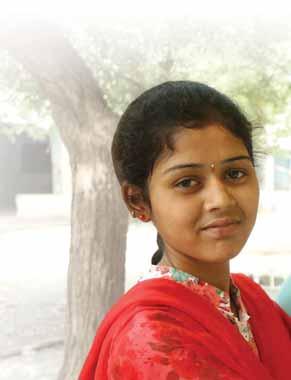

from the World Fund and DDF to fund operating expenses.
• Districts have to fully use rolledover DDF within five years. At the end of each Rotary year, DDF held in excess of five years will be applied at the district’s discretion or added to the World Fund. The first effect of this decision will commence from July 1, 2026.
Bhindeshwar Pathak, founder of Sulabh International that promotes environmental sanitation and waste management, shared ideas to tackle sanitation issues in our country. He explained about his ‘twin-pit-toilet’ technology where human waste is recycled into biogas and fertiliser.
“This solves the issues of open defecation and manual scavenging.”
Sulabh has set up thousands of public toilets (Sulabh Shauchalayas) across the country. The ‘Sulabh drinking water’ project converts arseniccontaminated water into safe drinking water, and his Duckweed-based technology for waste water treatment is economic and environmental friendly, he said.
Our participation should be such that Rotary should be considered as one of the foremost players for WASH projects across the country and the world.

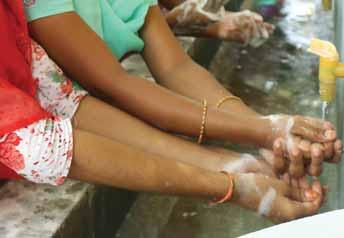
Shekhar
Mehta
RI President Elect

Erica Gwynn, Manager, WASH Area of Focus - TRF, congratulated India’s progress in the WinS Target Challenge as compared to other participating countries — Honduras, Belize, Guatemala and Kenya. She said that India did well in ushering in behavioural change in communities. “Investing in not only things, but also people through effecting behaviour change, improving their skills, enhancing their knowledge around water and sanitation services and elevating their education through scholarship programmes, ensures better sustainability of a project. This is often forgotten when we do projects.” Sanitation and hygiene programmes has seen a boost worldwide, as also irrigation-related projects, “thanks to such projects being implemented in India,” she added. To achieve an impact strengthening the environment around the system should be a priority. For better water resource management pollution and human activity around the precious resource should be addressed. “It will be like putting a bandage on the problem if you are thinking only about toilets and water treatment facilities,” Erica said. She stressed upon advocacy for the success and sustainability of any WASH system. “When you are planning a GG project or looking to engage larger partners like USAID, think about how you can leverage your relationship with the government and the communities that you work with because you will be that bridge to make a plan work.”
Nicolas Osbert, WASH Chief, UNICEF India; Suresh Redhu, Senior Vice President Eureka Forbes and RID 3110 DGN Pawan Agarwal, MD — Naini Group, Kashipur engaged in a panel discussion. RISAO’s TRF Manager Sanjay Parmar delivered vote of thanks.
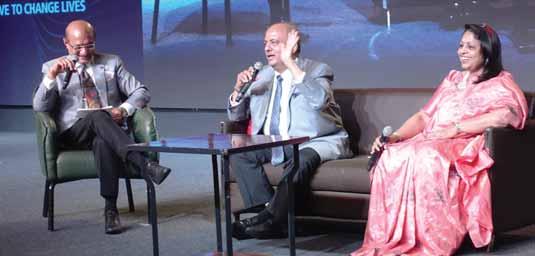
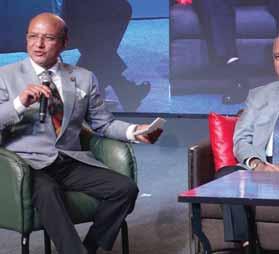
In an informal chat with RI Director Kamal Sanghvi at the opening session of the International Assembly in Delhi in January 2021, incoming RI President Shekhar Mehta said Rotarians will now have to focus both on Covid prevention and helping the government with vaccination, as well as continuing their efforts to rid the world of polio.
Excerpts:
Kamal Sanghvi: Please let us into your thought process on how you came down to this theme: Serve to change lives?
Shekhar Mehta: The final decision was fast but behind the essence of this theme there is 30 years of work. It was no secret that in my theme there would be the word ‘service’. Everybody knew that. But then when I sat down with the RI staff to discuss and finalise the theme, they told me that in the word ‘service’ there is no call to action. The solution was simple — we changed it to ‘serve’.
Now let me tell you about the word ‘change’. A few months ago, at a brainstorming session in Kolkata, where you were also there, (as well as the Editor!), somebody suggested that the word ‘change’ should be there… and at Evanston we agreed in 15 minutes that the theme should be ‘Serve to change lives’!
KS: What is the significance of the palm and the globe in your theme logo?
SM: In my opening speech at the International Assembly, I mentioned Swami Vivekananda who has said that don’t always receive, you have to also give. And when
we give, we stretch out our palm as it is depicted in the theme logo. And the globe denotes giving to the entire world. Hence a palm and the globe in the visual of the theme.
KS: How much of a role did Rashi play in your main speech at the IA?
SM: Oh, she is my biggest critic but she is a constructive critic and nothing escapes her eagle eye… she always tells me what is missing. This was one of the most important speeches I would make in Rotary so naturally there was a lot of back and forth with Rashi. Normally I give dictation but this time I wrote


the speech in long hand because dictation was not working… and Rashi said let’s do it.
KS: The President-elect’s handwritten speech will be auctioned at an event later!
You are a great votary of multidistrict PETS. Why hold multidistrict pets?
SM: Well, this was an American concept and till recently I didn’t think much of it. But if you give me a choice where to speak, I don’t like speaking at a district conference or assembly, but the one place I love to speak is at a gathering of
club presidents. Because it is the presidents who will take action on our talk and projects. And I’d like to meet as many presidents as possible. The only way to do that is at MD PETS.
In America, in the month of March (2021), you will be amazed to know that in 30 days I was supposed to be covering 24 cities, addressing 9,000 presidents! Now I am speaking to them online and have said there will be no taped messages. I still want to speak to each of them online, as right now that is the best way to connect.
KS: The advice, not a mandate, at the last RI board meet was that all the governors have at 30 per cent of women in different posts in the clubs and the district. All efforts should be made to encourage women. Is this a step in the right direction?
If you give me a choice where to speak, I don’t like speaking at a district conference or assembly, but I love to speak at a gathering of club presidents.
KS. Today the buzzword in Rotary is diversity, equity and inclusion of women in Rotary. I’d like to ask Rashi about her views on this and how will she influence Shekhar to include more women in Rotary.
Rashi. Including women in Rotary when it happened was a fantastic thing to happen in this organisation. And Jennifer becoming an RI President after Shekhar is a great step forward. I am certain that Shekhar will bring more women into Rotary as this is certainly one of his focus areas.
Rashi: I am not a great fan of reservation and when I hear about all women’s clubs, without undermining the effort which brings more women into Rotary of course, I must say that we should have the right balance of men and women. Diversity also means that we get the right balance, and not go for single gender clubs.
KS: Shekhar, there are six women in your life... your mother, two sisters, wife, daughter and daughter-in-law. Who do you love the most?
SM: I love all the mothers in this group… my mother, my son’s mother, my grandson’s and my nieces’ mother!
KS: Tell us a little about holding ‘Rotary days’ that you have been advocating.
SM. In India I expect at least 1,000 Rotary days to be observed during the coming Rotary year. The idea behind it is that we do so much work that makes such a big difference in people’s lives. We are very good at only talking among ourselves; in our Whatsapp groups, on our FB pages, etc. But the outside world doesn’t know who we are or what we do. So Rotary days will showcase what we do, take up a few projects, invite at least 30 per cent of non-Rotarians, and put up details about these on social media platforms. You can select your Rotary day… be it the world heart day, world literacy day or just decide on any day and do it. Just imagine the kind of public image it will build up for Rotary.
KS: So, governors please take this message to your presidents. I would like to call them Rotary service days. Shekhar and Rashi, what is the one fantastic moment in your journey of reaching the pinnacle of Rotary International?
SM: Too many moments to choose a favourite… our Rotary journey has given us so many outstanding moments.
Rashi. Various moments, as he said, but one thing I enjoyed the most was when he was working for Rotaractors for one year.
KS: If we consider rapid digitalisation, where do you think Rotary will be in the next five years?
SM: Hybrid. Absolutely. Our lives are going to be hybrid. There are such good things in the digital or virtual world that we certainly don’t want to miss. But the charm of physical meetings remains.… woh zoom pe milna bhi kya milna hei? (Appreciative applause from audience.)
KS: Now that the world is battling with the Covid pandemic, what will or should be Rotarians’ priority?
Rashi is my biggest critic but she is a constructive critic and nothing escapes her eagle eye… she always tells me what is missing.
We are very good at talking among ourselves; in Whatsapp groups and FB pages. But the outside world doesn’t know what we do. So Rotary days will showcase what we do.
SM: Our new task is to tackle Covid but our battle with polio still continues and will continue till we rid the entire world of polio. So what should we be talking about… Covid or polio? We have to do both. Covid is the new necessity but polio is our DNA. Let us not take our eye off polio at any time. And we are also going to be involved in Covid vaccination; the government is definitely going to require help and support from our organisation. Our Member of Parliament, Vivek Tankha is going to talk to the government offering Rotary’s help in the massive vaccination drive that India will have to undertake. (The IA happened in Jan, 2021, and since then Rotarians in India have been closely involved in Covid vaccination.)
KS: In a lighter vein, when you move to Evanston, who will do the cooking, cleaning and the dishes?
SM: I will invite guests on the condition that I will invite you for lunch or dinner but you will have to wash the dishes.
KS: Ok, on a serious note, I know that you always plan well in advance, at least 3–4 years. So what after the RI presidency?
SM: If I can break my mind’s shackles I would like to join politics. In Rotary, we spend so much time and energy and are thrilled if we do a project worth ` 1 crore. In government, the projects undertaken are so much bigger. The amount is not important but the number of people that the government can reach is phenomenal. Politics is nothing negative, service is a component of politics; I believe honest and fair people should join politics.
KS: Your favourite song?
SM: They are different; mine is jhilmil sitaro ka angan hoga, rimjhim barasta sawan hoga.
Rashi: Rahe na rahe hum, mehka karengey, bankey kali, bankey saba, baghe wafa mei.
V Muthukumaran
Youth have a role to play in the nation-building process as they are the trustees of posterity for the future, said RIPE Shekhar Mehta, after accepting the D Litt (honoris causa) presented by PDG Ashok Gupta, Chancellor of the deemed university India International School, Jaipur. “It is the duty of every citizen to uplift the poor living without a toilet and other basic amenities in the country,” he said. Mehta was conferred the D Litt for his work in literacy.
Recalling his past, he said till 35 he had led a luxurious life with all the comforts of a well-to-do family. “I got the first look at a different world in a village 50km from Kolkata, after I joined Rotary. Here men and buffaloes shared the same water for bathing, had no toilets in their mud homes, and a school with single teacher functioned under a tree with charcoal smeared wall as blackboard.” In India, he said, people lived in two separate worlds — one in which there is so much and in the other there is so little; there are people talking of space and living in skyscrapers on one side; and in the other, families live in hutments without basic sanitation. “It is our responsibility to change the living conditions of the underprivileged by reaching out to them,” he said.
In the last Census (2011) India’s literacy was just short of 75 per cent and at present, 20 per cent of adult population (18 crore) was illiterate. “Each one of you should make literate at least 10 adult illiterates. If we can accomplish this, India will become
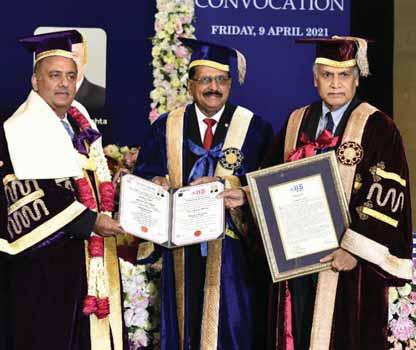
fully literate in just one year,” he said. Reiterating his vision to make India 100 per cent literate by 2025, Mehta said that “challenges and difficult tasks were stepping stones for successful people and as nation-builders, you have to make India a strong, powerful country.” While the country is progressing towards its deserving status in the world, “you can speed up the work in this direction,” he told the graduates.
Delivering the convocation address, Prof Sukhadeo Thorat, former UGC chairman and emeritus professor, JNU, said while the gender gap in the enrolment ratio and access to higher education has narrowed, “still many girls from notified communities, backward castes and Muslims do not have access to professional courses, private
colleges and English medium schools due to traditional bias, cultural factors and economic issues.” The GoI must come out with special schemes and incentives to set right these historical wrongs being meted out to Indian women, he said.
Justice Shivraj V Patil, former SC judge, who also received the D Litt, said the trinity of modern education — knowledge, skills and human values — is critical to make India a strong and happy country in the world.
Ashok Gupta, a past governor from RID 3054, recalled the International College for Girls (ICG) started in 1995 has become a centre for academic excellence in IIS which offers a wide range of progammes in science, arts, social science, commerce and management.
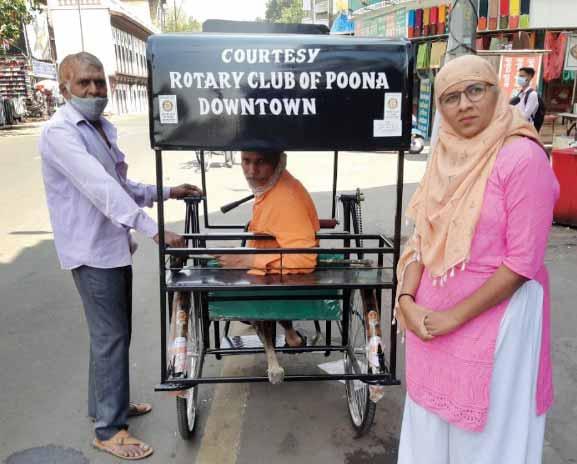
Reaching out to the visually-impaired youth, RC Poona Downtown, RID 3131, set up vocational centres at Luis Braille Apang Sanstha in Wagholi, a suburb in Pune, which has 100 boys and girls, and at Sai Guru Seva Sanstha in Narhe, a city neighbourhood, that hosts 20 girls.
Both the institutions sustain themselves by producing handcrafted items like bags, candles, caps, baskets and scarfs which are sold through market contacts. The
Wagholi home also performs orchestra shows at social and religious events to augment resources for the inmates. “We have donated three sewing machines along with raw materials such as cloth, knitting wool, beads and frames, weaving plastic, jute and other tools for them to start producing a variety of utility items and sell through their channels,” said Kirti Mehta, club’s director. He was hopeful that the vocational centres would provide monthly
revenue for taking care of the expenses at the two homes. The vocational centres ( ` 77,000) were funded by the CSR arm of Triveni Pattern Glass, apart from contributions from club members Aruna Rathi and Rama Sivaram for this project.
Prosthetic hand to aspiring girl
Young Anita Shinde was fitted with a prosthetic hand (Ottobock Myofascial) and was fully trained in its effective use by the club. Earlier, she wanted to become a
doctor, but “after examining her, we realised that her goal was not achievable.” She was given counselling by doctors, and Anita is now charged up to crack the UPSC and MPSC competitive exams with rigorous study, said Mehta.
Anita will be enrolled in a coaching academy in Pune for preparations to take up the exams. Out of the estimated cost of ` 3 lakh covering tuition fees, hostel charges, books, travel and other incidentals over the next one year, her family will bear ` 50,000 and the rest ` 2.5 lakh will be met by well-wishers and club donors.
Tricycles to differently-abled Physically-challenged Sudam Shinde from Yavat village, Daund taluk in Pune district, was donated a tricycle. “This gave a good visibility to our club and also enabled him to start a small business,” said Mehta. Another tricycle was given to Janardhan More from Shaniwar Wada in Pune and a third one sponsored by Rtn Dipti Bhonsle was
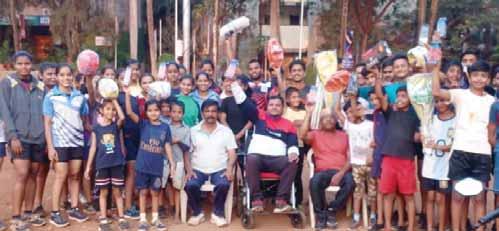
Wheelchair-bound Sagar Khaladkar with his students.
donated to Kailas Nivgune. “Now that they are mobile, we will support the beneficiaries in identifying suitable vocation to make them financially strong,” he added.
Following recommendations from Rtn Jitu Mehta and the club, the Pravin Masalewale Trust donated a range of sports equipment to the Abhijitdada Kadam Sports Nursery which is being patronised by the slum children at Kothrud. “The
children are being coached by Sagar Khaladkar who moves around on an electric wheelchair donated by our club,” adds Mehta.
Recently, the club donated an ECG machine ( ` 45,000) to the Family Planning Association of India, Pune, for scanning expectant mothers from lower strata of society.
The club has a long history of doing noteworthy projects
for the disabled and “this year under the leadership of president Phiroze Masters we are continuing with our tradition.” Chartered in 1986, the club is popular for holding mega LN-4 hand fitment camps in partnership with other Rotary clubs in India. “So far, we have distributed around 4,000 LN-4 prosthetics at more than 50 artificial hand fitment camps,” he added.
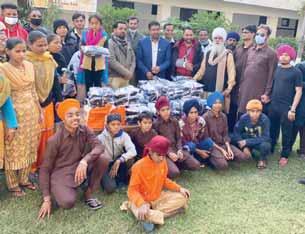
Rotary Club of Phagwara Midtown, RID 3070, presented jackets to the inmates of an old age home and an orphanage in Phagwara, a town 20km from Kapurtala in the Punjab. The club is providing provisions to these institutions every month since the start of the year.
Club president Surendra Pal Varma presented PPE kits to the ESI Hospital to provide protection for the doctors and care givers from Covid. The club members distributed immunity booster juice and nutritious food, masks and sanitisers to the public and patients at local hospitals.
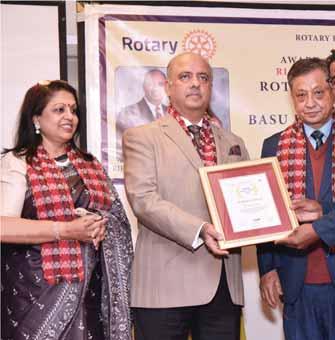

RIPE Shekhar Mehta and Rashi presenting a Rotary Journo Award to a journalist in the presence of PDG Kiran Lal Shrestha and DG Rajib Pokhrel.
Rotary clubs in Nepal and Bhutan under RID 3292 have grown strong after bifurcation from Kolkata, said RIPE Shekhar Mehta during his two-day visit to Pokhara, Nepal, in February.
He expressed happiness that he served as district governor (1999–2000) when Nepal clubs were part of RID 3290 before the district got divided into 3291 and 3292. He urged Rotarians to set big goals, and serve to change lives. “Rotarians must work hard
to make Nepal 100 per cent literate by 2030,” he said. All the 17 clubs from Region-4 of RID 3292, Nepal, felicitated RIPE Shekhar Mehta and Rashi.
RRFC Basudev Golyan and over 175 Rotarians including past governors were present at the programme. Event chair Keshab Prasad Acharya gave the welcome speech and IPDG Kiran Lal Shrestha introduced RIPE Mehta to the gathering.
Mehta handed over an OCT angiography
machine ($95,000) to the Himalaya Eye Hospital, Gharipatan. This GG project was supported by RC Akita North, RID 2540, Japan, which partnered with RC Pokhara Midtown, the implementing club. The equipment helps in treating retinal disorder in patients with diabetes and hypertension.
He also handed over 13 street lamps to the Bandipur Rural Municipality. This project was executed by RC Chitwan as part of beautification
of Bandipur to promote tourism. Addressing the presidents-elect, Mehta urged them to focus on teamwork and reach out to the needy. Service and membership growth should be their mantra, he said.
Awards for Nepal journalists Mehta presented Rotary Journo Awards and Basu Rotary Vocational Awards to 16 media people and journalists who had written or covered about Rotary projects across the
seven provinces of this Himalayan country.
In his address, he noted that Nepali journalists are working closely with Rotary for doing good in the world and “in the coming days media should continue to do so for the betterment of the needy.”
It was during the tenure of PDG Tirtha Man Sakhya (2011–12), the Journo Awards were instituted to build a good rapport between RID 3292 and the media fraternity.Each award carries a certificate of appreciation for enhancing the public image of Rotary and a cash prize of Nepali ` 25,000.
Mehta also handed over Basu Rotary

Vocational Awards for good governance to Ajay Babu Sibakoti, chief editor, Hamrakura.com and Prahlad Rijal from
Arthik Karobar , a popular daily. This award carries a cash prize of Nepali ` 5 lakh and a commendation letter each. The Basu
Awards ( ` 10 lakh) were sponsored by Rtn Surendra Govinda Joshi and his spouse Badri Laxmi.
hundred people from various walks of life in Kolkata were chosen this year to receive the endowment awards presented annually by RC Calcutta, RID 3291, through its welfare trust. The recipients included children from orphanages and economically deprived families who want to pursue education, differently-abled people, patients suffering from genetic illness, cash-strapped NGOs and children with exceptional brilliance in education and arts.
DG Sudip Mukerjee distributed the awards at the Rotary Sadan. The trust’s chairman Purnendhu Roychoudhury said
that the endowment fund had a corpus of `2.11 crore and the award money was distributed from the income
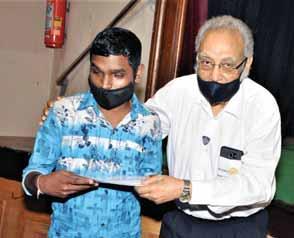
A visually-challenged beneficiary gets an award.
earned from the corpus which aggregated to `14.5 lakh. The applications were vetted by Arun Kumar Dutta, retired chief justice, Kolkata High Court.
PDG Prabhat Rohatgi who had initiated the scheme 29 years ago with just two donors said that he was happy that the corpus has grown to its present size facilitating its reach to more needy people. He committed a personal donation for the creation of another endowment in memory of his recently deceased brother Dilip Rohatgi who was also the club’s past president. Club president Debashis Mitra delivered a vote of thanks.


















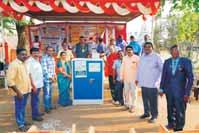

















Message from Rotary India Literacy Mission Programme Director
For children, books are similar to dreams and the most precisions gift one can give to child is the opportunity to dream.
I congratulate all clubs of RID 2982 who are participating in the “PADHO BHARAT” Library Creation and Creating 428 libraries in Rural Government & Aided Schools in Tamilnadu.
RILM is extremely happy to support the project with 24,000 books for donation. Under leadership of RID 2982 DG K S Venkatesan, DLCC A Venkateswara Gupta & Team together, we will create more such libraries in future.
My special thanks to TEACH team.
JHILAM ROY CHOWDHURY Programme Director, RILM.


Kiran Zehra
Inspired by the International Fellowship of Cycling Rotarians (FCS, that is, Fellowship for Cycling to Serve), RC Delhi Manthan, RID 3011, took the lead in forming the Indian International Fellowship of Cycling Rotarians and it has hosted two major events in April this year. Last year when the club organised the Ride to End Polio in Delhi and raised $10,000, the then club president came up with a plan to institutionalise the cycling activities in this part of the Rotary world. “Fellowship of Cycling Rotarians goes beyond pedalling, grand flag-offs and closing
events. It is all about fitness, fellowship and aims to raise funds for good causes,” says Narinder Kumar Lamba, club president.
While the first rally felicitated a cyclist Mahesh Kumar, who completed a 6,000km solo ride across India to promote peace, the second rally was a promotional event where members of the fellowship participated in a Cyclist Reunion, an annual event conducted by cycling enthusiasts in the national capital region.
Jean Luc Berger, president, International FCS, RID 1700, congratulated Lamba on the formation of the
cycling fellowship in Delhi. “They had organised a great ride in line with promoting Rotary’s public image as recommended by the fellowship,” he says and adds that FCS Germany organised a couple of virtual rallies through an app. “First, we had Eschborn-Frankfurt Velotour, through which we raised €27,000 along with the grant from the Gates Foundation for End Polio; this was followed by the climbing of the Pordoi Pass.” He praised the efforts of RID 3190 in organising a Cycling to Serve rally last July where the fellowship members helped 95 families by distributing food and ration kits. “The

Some members of the Delhi NCR Fellowship for Cycling to Serve.

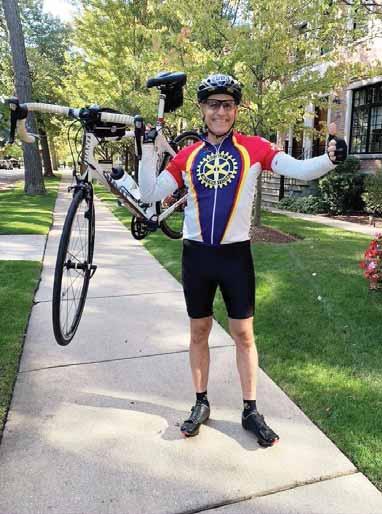
fellowship is not just about grinding away with perspiration while crossing the finish line to the cheers of supporters; the objective is to develop and promote worldwide friendship through cycling competitively and recreationally,” says James Morrison, vice-president, International FCS, RID 5340, US/ Canada.
DG Sanjiv Rai Mehra, RID 3011, appreciated the idea of a cycling fellowship for Indian Rotarians and Rotaractors. He named it the Delhi NCR Fellowship for Cycling to Serve. International FCS was formed 33 years ago by Rotarians in Belgium and France, says Lamba. With the support of local Rotary clubs and sponsors, a number of Rotary projects were implemented and millions of dollars were raised since its formation and through the Ride to End Polio. The Delhi NCR FCS plans to host an annual End Polio Now cycle rally on World Polio Day to create awareness and raise funds. People of all ages are discovering the health and mental benefits of cycling.
“Health, fellowship and service are accomplished with pedalling by Rotarians and Rotaractors. What better way to stay in shape?” smiles Lamba.
Avisit to a new facility being constructed by his company, Flint Group, at Vadodara, Gujarat, by Rtn Russell Taylor, secretary, RC Sussex Vale, UK, RID 1145, in August 2013 turned out to be a manna from heaven for over 2,000 students and teachers at five government schools in and around the city. They now have custom-built RO filtration units providing them clean drinking water.
Before taking up the RO installation projects, Taylor’s club, in association with RC Baroda Metro, RID 3060, provided 30 beds for children, who were sleeping on makeshift thin mats on rugged floor, at the Adarsh Nivasi Shala V J Kanya School. Having found a good partner club in Vadodara, he planned to install RO units in five schools — Adarsh Kanya School, Pandit Dindayal Upadhyay Prathmik Shala, Shree Patel Shivabhai Lallubhai Sarvajanik Vidyalaya, Samlaya, and two other schools in Dajipura and Desar villages — which were hit hard by water contamination. Students dropped out as there was no provision to supply clean drinking water in these institutions. “It all started with a chat over a cup of coffee Taylor had with us. And the Wheel was set rolling for humanitarian projects since then,” recalled Rtn Nitin Bhate from RC Vadodara One.
Practically all students had to carry a water bottle from home because of the bad quality of bore water at the school.
“As many students have to walk a long distance to reach their schools, especially those in villages, carrying a water bottle turned out be quite tedious for them,” said Taylor. While many simply stayed away from school, “those who came without carrying a water bottle
V Muthukumaran
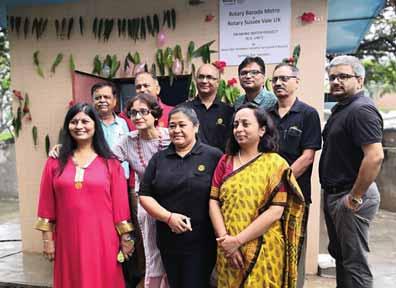
from home had to drink the unsafe water and were taken ill. This led to a steep fall in the school attendance,” he recalled.
Over a period of seven years, Taylor and his point man Rtn Nitin Bhate took up the installations of RO units at these five government schools in a methodical manner. The sponsor, RC Sussex Vale, has invested ` 6 lakh (£6,500) that covered the entire design, installation, maintenance and filter replacements for three years, after which the Vadodara club will bear the future maintenance expenses. “We did a detailed survey of each school by talking with headmasters and teachers. Each school had at least 250–300 students. We took pictures of the school premises and shared them with our global partner,” said Bhate. The RO units have different capacities based on the needs of each school. Looking back with satisfaction, Taylor said it was “fun to do such collaborative projects
and very rewarding to see the difference they have made to children’s lives.”
School headmasters were glad to report that the average attendance went up by 20–25 per cent after RO installations, and touched almost 30 per cent in village schools. Taylor is all praise for RC Baroda Metro for “their excellent planning and project implementation.”
Now, RC Sussex Vale has agreed to sponsor a similar RO installation at K H Patel Janpad Vidyamandir School, Khakharia taluk, by joining hands with RC Vadodara One. The project costing `1.82 lakh (£1,800) will provide clean drinking water to around 220 students and staff at this school. Technical details and costing which were worked out meticulously in the earlier successful projects would be followed with due diligence in this new RO project, assured Manisha Bhatt, president, RC Vadodara One.
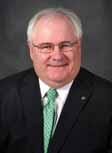
Three women polio workers — Nagina, a supervisor since 2012, Basira, a volunteer since 2016 and Samina, a volunteer in the last few
rounds — were shot dead while on their immunisation rounds recently in Jalalabad, Afghanistan. In addition, an explosion took place at the entrance of the cold chain office in Nangarhar province. No one was injured but there was damage to equipment.
RI PolioPlus Chair
Michael McGovern, in a statement issued from the RI headquarters, expressed grief over the loss. “We were deeply saddened to
hear of the loss of three polio workers in Jalalabad, Afghanistan today. As is our custom, we will provide immediate payments to the families to assist them in the short term,” he said.
Afghanistan National Polioplus Committee Chair Mohammed Ishaq Niazmand participated in meetings with the health minister and polio programme lead later in the day. Rotary and the Gates Foundation provided $1,500 each and
WHO Afghanistan provided $1,000. Ishaq will join a group delivering the funds to key known survivors in the next few days.
“We have provided condolences to the Polio Emergency Operations Center in Jalalabad. These incidents show the importance of working with all parties to finish the job of eradicating polio in the endemic countries. We all pray that there is no more loss of life,” said McGovern.
RIPE Shekhar Mehta handed over a refurbished P S Primary School in Sonbarsa, to the state education department on March 18 at Gorakhpur. RC Gorakhpur, RID 3120, has upgraded this and 15 other schools in the town through two global grants and CSR funding from Toyo Engineering India. With the club celebrating its platinum jubilee year, club president Arvind Vikram Chaudhary explained about the various milestone projects implemented by the club over the decades.
In his briefing, project coordinator M P Kandoi said around 5,500 children would benefit from the Happy Schools projects. So far, 26 Happy Schools have been completed under global grants. DG Karunesh Kumar Srivastava, DGE Samar Raj Garg and PDG Anoop Agrawal were present at the event.
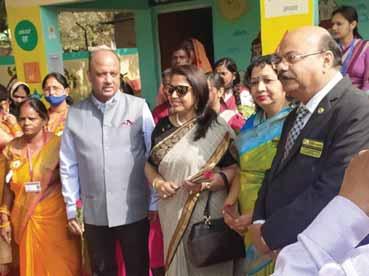
Mehta noted that with e-learning classes, the visual experience will benefit students and added that after the eradication of polio, achieving 100 per cent literacy in India is the next big task for Rotarians. He inaugurated a
mega health camp held in partnership with the Max Hospital, Delhi. DG Srivastava appreciated the club in taking efforts to increase membership even during the pandemic.
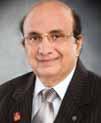
An update by the World Health Organisation shows over 144 million Covid cases till April 23, and over three million deaths worldwide. WHO is bothered, and we the Rotary fraternity must be bothered too and ensure that leaders at the local level take action to save millions of people.
Rotarians should ensure that shortcomings in the healthcare system should not kill people. In this hour of national and global emergency, Rotarians have to show that they care. Rotary cannot allow patients to sign their own death warrants due to lack of vaccines, oxygen, beds and other medical facilities. We cannot waste time blaming the administration for fatal errors and not having a contingency plan in place for the second wave. Our misplaced sense of pride in containing the first wave probably made us complacent.
Rotary has to provide the emergency help so that people will have a chance to survive. We Rotarians have shown that everything is possible. When we get rid of Covid with our collective effort, we can celebrate the fact that this victory belongs collectively to all of us.
Rotary in India is actively promoting Covid vaccination in various districts. Rotary clubs are zealously organising vaccination camps and
assisting in setting up vaccination centres. The Government of Haryana has invited Rotary India’s Covid Task Force to help it in the mass vaccination programme. I congratulate Zonal Coordinator PDG T K Ruby (RID 3080) for arranging this partnership.
The Tamil Nadu government has invited Rotary to assist in its Covid vaccination drive. RC Madras, led by president Kapil Chitale, will provide two fully-insulated AC vans for transporting vaccines. Doctor volunteers will be made available at the centres and arrangements are being made to store vaccines.
Rotary clubs have set up over 50 Covid vaccination centres in Kerala and each day at least one centre is being added to the tally. The vaccines and vaccinators are provided by the state government. SBI is equipping the centres with computers and operators, and Rotary is providing infrastructure and the facilities needed to run the centres. Almost 50,000 free Covid
Rotary has to provide the emergency help so that people will have a chance to survive.
vaccines have been given through Rotary vaccination centres and camps across the state.
The Rajasthan government has signed an MoU to work with Rotary as its official partner. We are aiming to set up at least 1,500 vaccination centres across Gujarat and in Uttar Pradesh all vaccination centres have a selfie point installed by Rotary.
In Maharashtra oxygen concentration machines are provided in some hospitals and more such machines will be made available. Rotary clubs have put up information centres at various locations where people can know how to register and where to get vaccinated. Senior citizens are provided special assistance. In Mumbai, following a request from the municipal corporation to maintain the cold chain at the centres, 10 medical refrigerators have been provided and more will be donated in next few days.
Posters with messages from Rotary leaders in support of vaccination are being spread by Rotarians through social media.
Every member of our team is totally committed and we are fortunate to have committed district leaders who understand the seriousness of the cause and are ready to support.
The writer is a past Rotary International director and chairman, Rotary India’s Covid Task Force.
Project Orange of RID 3232 aims at combating avoidable blindness by setting up 200 hybrid vision centres (HVC) covering 2,500 villages and one crore beneficiaries in the initial phase. “We will be giving spectacles to 25 lakh beneficiaries and perform surgeries on five lakh patients,” said M Nachiappan, associate project chairman, adding that the overall cost for the first set of 200 vision centres will be `25 crore.
So far, seven global grants worth $1.6 million were approved to set up 104 vision centres with the participation of 32 clubs across five districts. RID 3232 is in partnership with eight eye hospitals including L V Prasad Eye Institute, Sankara Eye Hospital and Aravind Eyecare System, and eight foreign clubs for implementing Project Orange
The district recently inaugurated 10 HVCs on the outskirts of Chennai and six more HVCs will soon be set up at places near Chennai such as Mahabalipuram, Vyasarpadi, Uthukkottai and Padappai where
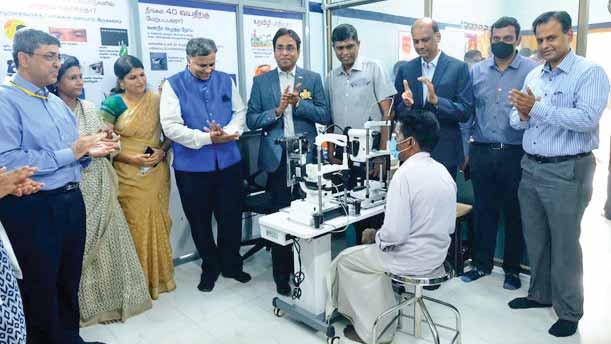
specialised eyecare is not possible.
“Our objective is to reach out to at least one crore beneficiaries within the first year through 200 Orange HVCs. The cost is just `22 a person,” said DG S Muthupalaniappan.
Each HVC will have an optometrist and an ophthalmic assistant, who will be supported by eye specialists at the base hospitals, said Nachiappan. “The assistant will visit rural areas to screen people for refractive errors and other eye ailments.”
During the first phase of the roll-out, the project has given employment to 700 rural people, while 1,500 were benefitted indirectly.
Giving a perspective of the eyecare in the country, he said that India requires at least 20,000 vision centres as against the present availability of 1,000-plus centres. In India, 8.8 million people are blind, and 80 per cent of their blindness is curable. “But only 10 per cent have access to proper eyecare. Each HVC cluster will cater to a population of around 500,000.”
Each HVC will have a range of equipment to treat eye diseases in consultation with the telemedicine ophthalmologist from the secondary care centre (base hospital). An HVC
will have mobile vision care units (MVCUs) and an Advanced MVCU catering to around 60,000 people.
Eight HVCs along with eight MVCUs and one AMVCU form one HVC cluster to render primary eyecare to the rural, semi-urban and slum communities. “Patients in need of further treatment or surgery will be directed to the secondary care centre,” said Nachiappan. RID 3232 has made promotional films to propagate Project Orange in communities. “We have designed strategies to grow exponentially in the coming years towards combating avoidable blindness in India,” he said.
’forgotten food’ back to the plate and giving a stimulus to its consumption so as to ensure nutritional security besides helping farmers — this was the aim when RC Mysore West, RID 3181, organised a two-day ‘Roots and Tubers Mela’ in Mysuru recently.
The event, partnered with Sahaja Samruddha that promotes sustainable agriculture, had farmers from across the state showcasing varieties of tubers and roots “most of which look alike but have different nutritional elements,” says club secretary Dinesh Kumar D K. Elephant foot yam, fresho yam, lesser yam to name a few may sound familiar but there are a hundred whose names are as exotic as their shape and size, he adds.
There are scores of varieties like purple yam which is used in ice creams and cakes, though many varieties have not yet been documented, says Krishanaprasad of Sahaja Samruddha,

Rotarians at the exhibition.
adding, ‘’certain tubers and roots can be a source of food security at the household level and our intention is to promote their cultivation in the backyard so as to ensure adequate nutrition for the local populace.”
Mysore Maharaj Yaduveer Krishnadatta Chamaraja Wadiyar inaugurated the mela. Tubers and roots has many benefits as they can sustain in water-stressed regions, did not require
chemical fertilisers and pesticides. They are beneficial to the farmers as the input cost is next to negligible while ensuring food security, he said.
The event saw over 15,000 visitors and more than `12 lakh turnover.
RC Mysore West president Dr Ragavendra Prasad, PDGs Joseph Mathew, R Krishna and G K Balakrishna were present during the inaugural.
AFebruary morning air on the banks of River Yamuna near the ITO
Bridge in Delhi was filled with mellifluous music.
Over 250 people enjoyed

a jugalbandi presented by Siddharth Banerjee on the Siddha Veena and Ustad Fateh Ali Khan, grandson of Ustad Bismillah Khan, on the Shehnai.
The event — Ragas for Yamuna — was organised by RC Delhi Manthan, RID 3011, along with an NGO Bhatium, “to create awareness and impress upon the who’s who of Delhi the urgency to clean and rejuvenate the Yamuna flowing through the
city”, says club president Narinder Kumar Lamba.
The jugalbandi was the first of a series of events planned by the club for the campaign. “We have got together a legal team to file a case with the National Green Tribunal to pass an order to discharge only treated effluents into the Yamuna, and another team to reclaim the land on the river bank and clean it,” says Lamba.
Rotaractors and Rotarians are both constantly learning from each other when they work together which is great and for Rotary as an organisation, there is still much to learn about how best to support Rotaractors on a broader scale, said PRIP Barry Rassin in an interactive session with PDRR Nishita Pednekar, RID 3170, at the virtual International Assembly. He added that RI has changed many policies and procedures to “enable Rotaract clubs and Rotaractors to function in the same manner as Rotary.”
But the challenge is to change the culture of Rotary clubs to be more accepting of young professionals. “We must listen to their aspirations more, and how they believe clubs should operate and include them in all of our committees,” he added and pointed out that Rotaractors have enthusiasm, are comfortable with today’s world. “They have an amazing sense of creativity, and a strong desire to make our world a better place. We need all these assets in Rotary.” He said RI’s governance structures
must be looked into, so that it could figure out how to make room for Rotaractors, and other voices, to be included in the decision-making processes.
Rotaractors bring energy that some of the Rotary clubs have lost along the way, but they can only bring that energy when they feel welcomed.
“That’s the task at hand for Rotarians: welcoming younger members.”
To a question from Rassin on attracting new members including Rotaractors, Nishita said, “the best way to attract new members is through social media, so whether you’re a Rotarian or a Rotaractor, I would say that you need a strong social media presence and a clear voice.”
Every initiative must be shared on social media as it would build awareness of Rotary’s impact and expand its reach, she said.
Once new members join, they can bring in new ideas and energy.
But the key element, said Nishita, is how well the existing members bond with them and inculcate the morals of Rotaract. “That’s what makes new
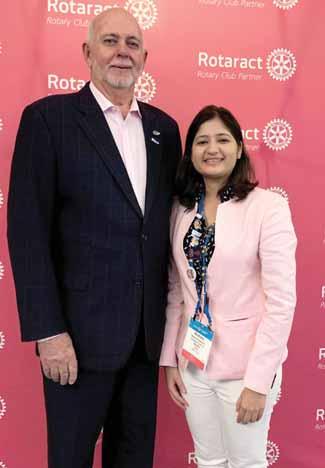
members stay. It’s all about teamwork, and listening to each other’s opinions and ideas.”
Agreeing with Nishita’s suggestions, Rassin called upon Rotary clubs to work together to “make us more relevant to young professionals. The way to do that is by including them on leadership teams so they can make
contributions, learn by doing, and get valuable experience.”
With lot of creative energy, Rotaractors are willing to take risks and rise to meet a challenge, said Nishita. “We really want to make an impact. Logistically, we are prompt, and we make sure to deliver what’s promised,” she added.
V Muthukumaran
Smiling faces and mutual greetings among Rotarians created a joi de vivre at the venue as DG Dr Thomas Vavanikunnel inaugurated the Rotary Dialysis Centre with two machines and an RO plant at the Mercy Hospital in Thalayolaparambu, a town in Kottayam district. RC Kottayam North, RID 3211, completed its maiden dialysis project through a global grant worth ` 32 lakh. The project was completed with support from RC Lakewood, Washington, US, RID 5020, and club members contributing ` 7.5 lakh as their share. “We also donated two dialysis machines and cots at the Sacred Heart Medical Centre as part of this project. They already have 10 machines and our new units will supplement their facilities. We have signed an MoU with them for sponsoring 440 dialysis to needy patients every year,” said club president Joseph K J. While ` 18 lakh was spent on setting up the dialysis centre at
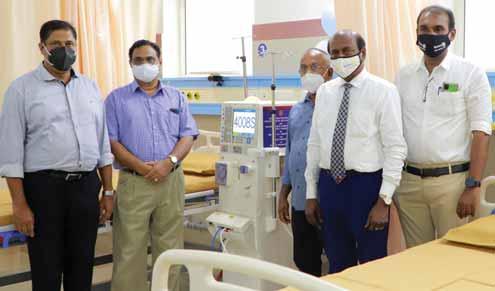
the Mercy Hospital, the balance ( ` 13 lakh) went for the installations at the SH Medical Centre. The one at the Mercy Hospital will do 550 free dialysis for needy patients.
Under the Save Kidney, Save Life Project, the club along with the Muthoot M George Foundation extended free dialysis to 20 patients at a cost of ` 2.34 lakh.
Chartered in 1981, the club lifted its public image four years ago when it implemented WinS projects on a big
scale. Recalling those days, Joseph said, “we built a toilet block at a government high school, staged a number of demos on best hygiene practices in schools and also installed a couple of handwash stations. It was a PR success as people took note of us.”
With total membership at 49, the club has so far done eight small-scale community projects this year at an overall cost of `4 lakh. The club gave ` 37,500 to a needy patient who had
valve replacement. “Our grant will take care of her post-operative treatment and medical expenses,” he said.
Ten pulse oximeters worth `20,000 were donated to the district corona cell, Covid First Line Treatment Centre. “We provided television sets for two poor students to attend online classes.”
The club still takes care of the maintenance of a rest room it set up for both genders in 1988 at a private bus terminus in Kottayam.
Contributions from donors in India are received by Rotary Foundation (India) on behalf of TRF.
Contributions can be made through cheque/bank draft and mailed to RI South Asia Office. Contributions can also be done online through Rotary website: www.rotary.org by using credit/debit card or net banking option.
All contribution to RF (I) is eligible for 50 per cent deduction under section 80G of IT Act, 1961.
TRF guidelines for re-classing contribution
2021 Convention
Current year requests for re-classes will be accepted and processed if received within 60 calendar days of the gift receipt date and within the same Rotary year.
Requests for transactions involving the prior year re-classing (correction) of contributions from any Rotary Foundation fund, project or programme to any other fund, project or programme cannot be accepted and processed following the close of that fiscal year.
Major Donor recognitions
Individuals are recognised as Major Donors based on their personal contributions. Major
Donor status cannot be bestowed on an individual based on support from another donor or donors or a “matched” contribution, either in part or full, by a district, other entity or corporate.
In case of a contribution made by a family-controlled company or a family trust, it may officially provide in writing that the actual credit be given to the owner or trustee of the trust. Only contribution by a spouse can be linked to an individual’s Major Donor recognition. Merging of contribution from lineal descendants or ascendants (grandparents/parents/siblings/ children etc) do not count for Major Donor recognition.
Rotary International Convention attendees know that it’s important to arrive early because even before the convention gets underway there’s always plenty to do. Preconvention events offer a lot of great information as well as opportunities to connect with other Rotary members. With the 2021 convention transformed into a virtual event, travel logistics are no longer a factor, and these preconvention gatherings are open to all. This is a great year to participate in everything that comes before the main event.
Rotaract Preconvention: This event offers the chance to increase your understanding of Rotaract, to learn from and share tips and ideas with other participants, and virtually network with Rotaractors and Rotarians from around the world.
Rotary Youth Exchange Officers Preconvention: This virtual event will provide you an opportunity to network with Rotary members and volunteers involved in Rotary Youth Exchange. You’ll also gain vital knowledge that will help you improve your local programme or get one started.
Intercountry Committees Preconvention: This event, called Opening Opportunities for Peace , will feature
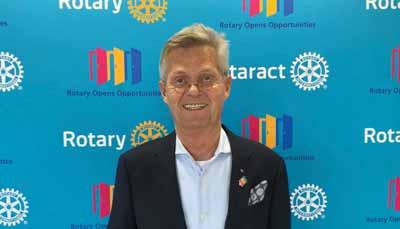
inspirational speakers, practical breakout sessions, and networking opportunities to help you start or expand an intercountry committee relationship in order to foster goodwill and peace around the world.
The 2021 convention will be held June 12–16; all preconvention events will take place June 10–11.
Learn more about the virtual convention and preconvention at convention.rotary.org.
RC Gudur, RID 3160, recently distributed large umbrellas to street vendors in Gudur town, Nellore district, to protect them from the harsh sun or mild rain. The brightly coloured umbrellas on the market area will enhance Rotary’s public image, says club secretary Sridhar Reddy Bandi.
The club, chartered in 1963, boasts of having constructed two crematoriums, a clock tower and a Rotary Hall in Gudur. “We established the first college in the town in 1965 with generous contribution from club member Sannapareddy Krishna Reddy. Today it has 1,000

students,” he recalls. The Dvurru Ramanamma Women’s College constructed by the club in 1981 provides quality education to 2,000 young women. Both colleges have been handed
over to the government now, he adds. The Rotary Helpage project launched in 2005 by Alluru Adisesha Reddy to support aged destitute people with monthly groceries is still active.
The Rotary Nagar at Puritipalem, a flood-prone locality, has 30 concrete houses constructed with matching grant support initiated by PDG D Bhaskar Reddy.
RC Hanumangarh Central, RID 3090, joined hands with RAC Hanumangarh, to conduct a blood donation camp at the Rotary Bhawan. A total of 83 units of blood was collected, with the
doctors and medical staff of the Life Line Blood Bank in the town extending their service at the camp.
Chief guests Dr Jyoti Dhingra, block chief medical and
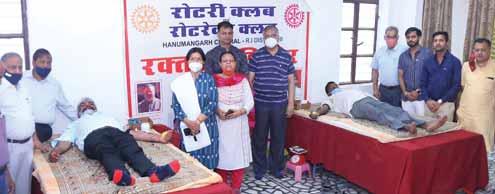
health officer (CMHO), and Prof Suman Chawla, social worker, appreciated Rotary for organising the blood camp which filled an emergency need of critical patients. Amar Nayak who holds the Guinness Record for donating blood 86 times was one of the donors at this camp. Club president Kapuary Lal Garg and secretary Hemant Goyal were present. Covid protocols were followed by Rotarians and the donors. Project chair Jitesh Goyal gave the vote of thanks.
V Muthukumaran
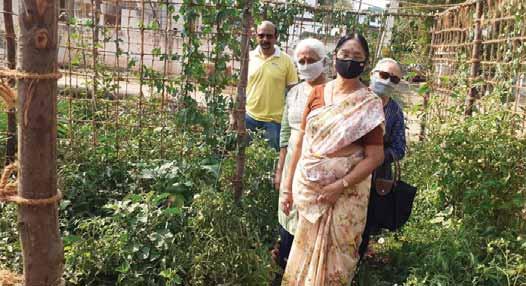
Afive-cent vacant land has been converted into a vegetable garden at Vadavalli, a city neighbourhood, by RC Coimbatore Midtown, RID 3201, with the landowner’s consent. “The fresh produce after harvest will be sold to the local residents at a reasonable cost,” says S Badrinath, member, club’s Communication Services.
Project Kitchen Garden will be supplying vegetables grown through organic farming, provide employment opportunities and promote the concept of greenery in vacant plots in Coimbatore. “Within a short time, the project has become popular with many clubs visiting our site,” he says.
Club president S Palaniappan, secretary Hari Bhaskar and other members were involved in the project which was started after fulfilling
the legal formalities in December last year. Initially, the club had to contend with the clearing of wild parthenium weeds and building debris which posed a major challenge. C Srinivasan, an expert in solid and liquid resource management from Vellore, guided the Rotarians in the project implementation. “First, he helped to plant 100 varieties of greens and lettuce on this plot. With inputs from other experts, we planted other vegetables such as brinjals and tomatoes. We made it into a community effort with everyone from the locality pitching in by offering inputs such as organic manure and water,” explains Hema, spouse of Rtn Jitendra Khona. She initiated the idea of kitchen garden six months ago and it was later on taken up by Priya Palaniappan, wife
of club president, with the rest of the Rotarians.
On a higher scale, such a vegetable garden will cost ` 1.5 lakh, “but it can be much less if we have a good piece of vacant land without any debris or garbage dumps on it,” says Hema. The club is planning to install a drip irrigation system at the project site soon to water the plants.
After summer, the club will be replicating the kitchen garden in other empty plots at Vadavalli and income from such organic farming will be ploughed back for the benefit of the community, she adds.
“We are glad that the land is put to beneficial use until its owner constructs a building. Otherwise, it will turn out to be a haven for anti-socials or a breeding ground for poisonous creatures,” says Badrinath.


It doesn’t matter if you live on the seventh floor of a high rise or in a ground floor house with a garden. The person with a green thumb and love for nature will always manage to conjure up green spots which sprout seasonal flowers, herbs and even vegetables. And if you are inclined to nourish your plants with healthy nutrients generated from your kitchen waste rather than harmful fertilisers, it is not difficult. To generate rich humus for the potted

Preeti Mehra
plants in your balcony, terrace garden, outdoor lawn, or vegetable patch, all that is needed is a little effort.
It is called composting or decomposing organic waste into simpler organic and inorganic compounds. To get started keep a separate ‘wet’ waste bin in your kitchen and instruct everyone to dispose vegetable peels, used tea leaves, ground coffee and waste food in it. The waste must then be collected and regularly emptied into a composter bin which can be kept in


your balcony, terrace or a corner of the garden.
Through this simple act you will divert almost 30 per cent of your household waste away from garbage heaps and landfills. It is well-known that when organic matter is dumped in a landfill there is not enough air to decompose it quickly, hence harmful methane gas is produced as the waste breaks down. This adds to global warming which is responsible for climate change.
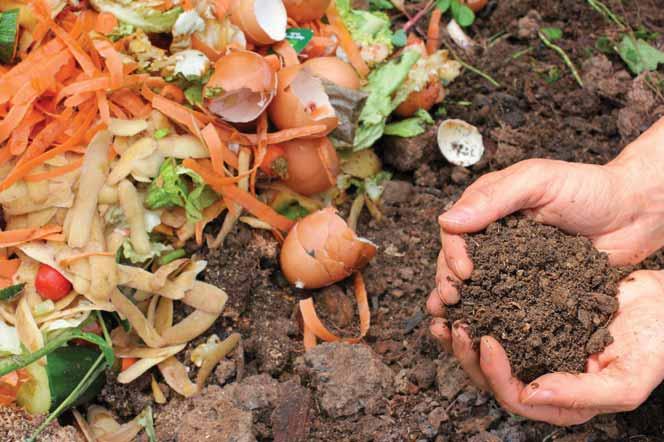




In contrast, when you compost, the microscopic organisms which help the process of decomposing aerate the soil. They also break down the organic material put in, nourishes the plant, and keep away plant diseases. By composting not only are you performing a green deed, but the ‘black gold’, as the humus generated is called, adds nutrients to your green shoots and helps retain soil moisture, giving you the best manure possible for your plants.


But what is the mix that goes into a healthy compost? Composting requires material rich in nitrogen (green) and carbon (brown) and the right mix of both is what gives the best results. Nitrogen-based matter includes food leftovers, leafy vegetables, and clipped grass from mowing. These provide raw material for making enzymes and help microorganisms multiply. The compost gets its body from carbon-rich material like dried leaves, eggshells, ground coffee, tea leaves, saw dust, brown paper bags or wood-derived cutlery, ice cream sticks etc. They provide the food for the microorganisms. It is best to use one-third green and two-thirds brown in the mix.
So far so good. But how does one go about composting? The easiest way is to invest in a few composting bins. These can be rotated to ensure a steady flow of manure. Buying specialised bins is convenient since it

reduces the effort required in building one at home. Amazon has some 15 options, and some come with compost maker mix and jaggery to speed up the decomposing. They cost between `1,000–3,000.
It is best to read reviews of each of the options, look at the waste your kitchen generates, consider your budget, and then order the one that suits you best. The composter bins come with detailed instructions on how to set them up, what goes in at what time, and when the manure is ready to use. It usually takes between four to six weeks for the waste to be converted to compost.


Through the simple act of composting you will divert almost 30 per cent of your household waste away from garbage heaps and landfills.
There are several tips that will help you master the process of making compost. Here are a few of them:
* It is advisable to chop or cut what you put in the compost bin as it speeds up decomposition.
* Try to avoid adding pesticide treated material into the composter.
* Collect substantial quantities of waste so that it packs the composter bin. This increases the heat inside and speeds up decomposition.
ing process. Some compost bins automatically carry out this task.
With the microbes working, you are on the way to harvest your black gold. But how do you know when the manure is ready? Experts say all that needs to be done is to dig your hand into the manure. If it is warm inside, its done. Others recommended using a compost thermometer. In a compost pile that is working well the temperatures are between 140 to 160°F and can go up to a “cooking” 170°F.

* Keep the bin in the sun for a while to activate the microbes.
* Stir and turn the mix occasionally to air it and speed up the compost-
Compost also needs the right amount of air and moisture (40–60 per cent) to mature. In a dry bin dampness can be enhanced by adding fresh wet waste, conversely dry waste can reduce excess moisture. But these nuances generally come through experience.
Often, residential complexes organise collective composting in larger bins or pits. That makes things easier as a system is created. But for those who want to compost at home, the proof of the pudding is in the end-product. It smells, looks, and feels like rich dark soil that deserves the epithet ‘black gold’.


The writer is a senior journalist who writes on environmental issues.


























































Just mention her name, and music lovers get misty-eyed.
Geeta Dutt had an exquisite, almost ethereal voice, and gave Bollywood music some of its most radiant gems during the late 1940s and 1950s. Hers was a short but resplendent life and career, which ended tragically in 1972 when she was only 41.
Her voice defied analysis and inspired adoration. It could articulate melancholy with scorching intensity, with a faint tremor that heightened its impact. It could project mirth or playfulness with an infectious sprightliness. O P Nayyar described her voice as a “natural miracle”. She was referred to as a skylark, a ballerina of song. No playback singer could convey feelings better than Geeta Dutt, said music historian Ganesh Anantharaman. Manna Dey said that Lata Mangeshkar and Asha Bhosle had imitators, but none could imitate Geeta Dutt. Film music critic Raju Bharatan said


S R Madhu

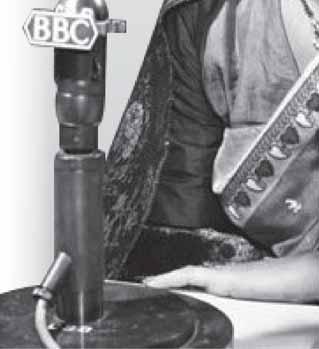


Geeta did not sing, she glided into a song.
Geeta sang some 1,200 songs — mostly in Hindi, but also in Bengali and Gujarati — of which at least 50 were superlative. She was the No 1 singer for two years from 1947 after the song Mera sundar sapna beet gaya in the film Do Bhai became a sensation. Never had the searing pain of lost love been conveyed so memorably, so magically, as in this song — which 16-year-old Geeta rendered for S D Burman in a voice of intoxicating sweetness. All of India was captivated. Disc sales of the song shattered records. The song mesmerises even today. Geeta was dethroned as No 1 by Lata Mangeshkar after the phenomenal success of Mahal, Barsaat and Andaz in 1949. But it is said that the one singer Lata feared till the late 1950s was Geeta.

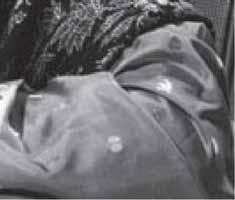

The beginnings
Geeta Roy Chowdhury was born in 1930 into a rich zamindar’s family in Faridpur, now a part of Bangladesh. In 1942, when she was 12, her parents moved to Bombay because the Quit India movement had become an anti-landlord movement. It was a steep downturn in fortunes for the once-prosperous family.
The family lived in a modest flat in Dadar. Geeta was fond of singing and humming. Music composer Hanuman Prasad overheard her once, and was entranced. He engaged Geeta to sing a couple of lines in a chorus song in the movie Bhakta Prahlad (1946).
Geeta caught the attention of S D Burman, and her talent blossomed under his direction. She sang six songs in the 1947 Do Bhai. Mera sundar sapna, filmed on Kamini Kaushal, immortalised the film and conferred instant stardom on the singer.
Geeta scored another resounding triumph with her sublime Meera bhajans in the 1950 Jogan, a Dilip Kumar-Nargis starrer, in which she sang 12 songs. Nargis’s serene beauty, the melody of the songs and the religiosity and depth
of feeling Geeta imparted to them enthralled listeners. Ghungat ke pat khol has acquired iconic status, but Mat jaa mat jaa jogi, Main to giridhar ke ghar jaoon and Aeri main to prem diwani were also devotional stunners.
She was inundated with offers and sang for many composers. (Khayalon mein kisike in the 1950 Bawre Nain for composer Roshan, a duet with Mukesh, was a beauty.) But she got branded as the voice of bhajans and melancholia. However, S D Burman engineered her image makeover through the 1951 Baazi, directed by Guru Dutt, where she sang the saucy, jazzy, mischievously seductive Tadbeer se bigdi huyi taqdeer bana de. It was filmed on Geeta Bali teasing Dev Anand. Both the Geetas









It is said that the one singer Lata feared till the late 1950s was Geeta.















excelled. Dev Anand says many fans saw the film just for this song, and left the cinema hall after the song was over!
This song was special for another reason. Aspiring director Guru Dutt met her during a recording of the song, and fell head over heels in love with the dusky, doe-eyed, long-haired beauty. Guru’s family too was charmed by her humility and affectionate disposition. She would drop in at their house, play the harmonium or sing songs. Geeta’s family was less enthusiastic about the romance, one reason being that Geeta was the family’s breadwinner. But eventually, Geeta and Guru got married in 1953 in a fairytale wedding in Bengali style, and the lovely bride, clad in a red Banaras sari, stole all hearts. The superstars of Bollywood music took part: Lata, Rafi, Kishore, Hemant Kumar, Talat Mahmood. And all of them sang!
The O P Nayyar connection
If S D Burman introduced Geeta to the limelight, O P Nayyar made it seem that she belonged there. She sang four solos in Nayyar’s first film Aasman (1952) including the splendid Dekho jaadubhare more nain
and the soulful Dil hai deewana The film bombed, but these songs won high praise. Geeta did O P a great favour by recommending his name to Guru Dutt for his film Baaz (1953). Once again, Geeta excelled but the film flopped. But Nayyar then delivered brilliantly for Guru Dutt with three musical blockbusters. His forte was feisty, spunky, sprightly songs of hope and optimism. And Geeta gave them life and voice.
She scintillated in Aar Paar (1954) with Babuji dheere chalna filmed on Arabian
beauty Shakila — arguably the most popular night club song in Bollywood history. Equally infectious were Yeh lo mein haari piya, Hoon main abhi jawan, and Ja ja ja ja bewafa. In Mr & Mrs 55 (starring the beauteous Madhubala and Guru Dutt) every song was a delight. There was the effervescent group song led by Geeta — Thandi hawa kaali ghata aa hi gayi jhoom ke. (Raju Bharatan remarked that Geeta herself was thandi hawa and khali ghata rolled into one.) There were two breezy Geeta-Rafi duets,
The superstars of Bollywood music — Lata, Rafi, Kishore, Hemant Kumar, Talat Mahmood — took part in Geeta and Guru Dutt’s wedding. And all of them sang!
Geeta being decked up by her friends Geeta Bali and Smriti Biswas.
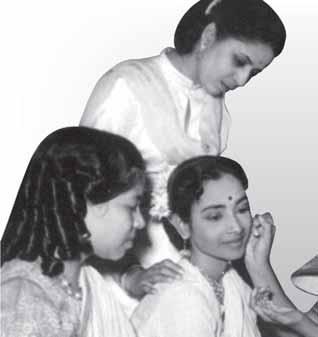
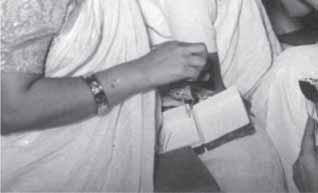


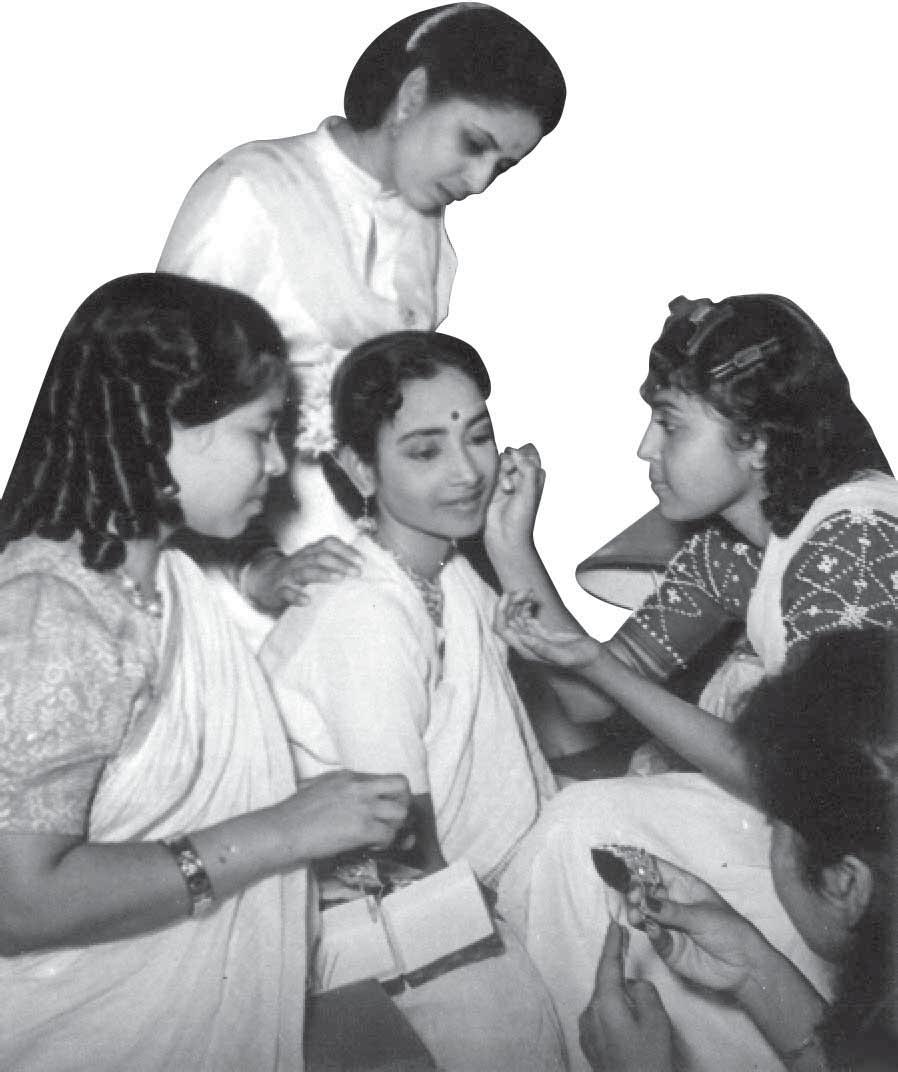
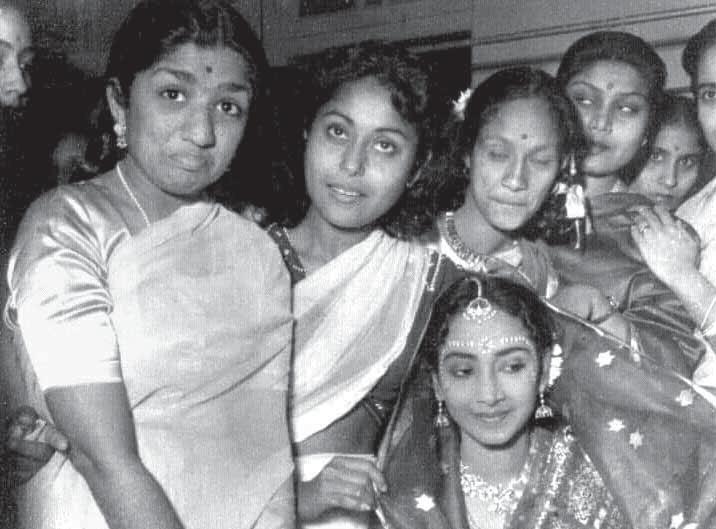
and the achingly beautiful yearning-for-the-lover song Preetam aan milo.
In CID, Nayyar gave Bollywood the sizzling Geeta-Rafi duet Yeh hai Bombay meri jaan (which was much loved and recreated in university campuses); a second feisty duet by the same pair (Aankhon hi aankhon mein ishara ho gaya), and the effervescent Geeta’s romantic hit Jaata kahan hai deewane. Under Nayyar, the singer of sweet melancholy was becoming the epitome of insouciance!
Geeta sparkled in some songs outside the Guru Dutt banner as well. Examples: the 1954 Na ye chand hoga in Shart for Hemant Kumar, which was drenched gently in love; and the 1956 Bhai Bhai song Ae dil mujhe bata de, which exemplified the exhilaration of teenage love, for Madan Mohan. The peerless Lata sang eight songs in Bhai Bhai and Geeta just one — but it’s Geeta’s song that made the best impact!
1957 saw Guru Dutt release the brooding Pyaasa, about the exploitation of a poet by society. It turned out to be a landmark movie. S D Burman’s music was a tour de force. One of the standout songs was Geeta Dutt’s bhajan Aaj sajan tohe ang laga lo, which reflected both eroticism and bhakti — something Geeta’s musical genius managed splendidly. The song began on a low octave and rose to
a spell-binding crescendo. She also sang the flirtatious Jaane kya tune hi filmed on Waheeda, and a melodious romantic duet with Rafi — Hum aapki aankhonme. Geeta had demonstrated awesome versatility through a single movie.
The troubled years
When Geeta married Guru Dutt in 1953, her career was on song, while Guru was a struggling director. Reports that he had married Geeta for money enraged Guru; he told Geeta to stop singing for other banners. She was devastated, this was like depriving her of oxygen. She took to singing on the sly for other composers, and when Guru discovered this, he exploded. Dark clouds began to hover over what was once a fairy-tale marriage, despite three children whom both parents doted on.
Waheeda Rahman entered Guru Dutt’s life in 1956 with the film CID, and the stories of his infatuation for her pained Geeta. She had almost surrendered her career for her husband, and she
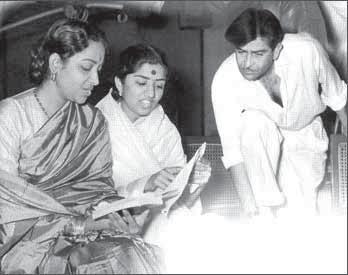
























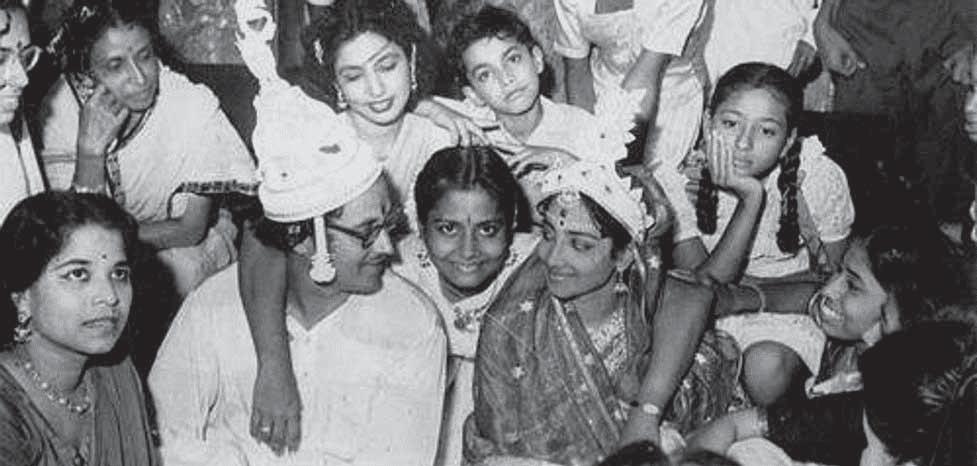
couldn’t bear the idea of losing the husband to another woman. Geeta took to the bottle to drown her sorrow.
To placate Geeta, Guru offered to make a film with her as heroine. She was delighted, but Gauri got abandoned after some heated quarrels between the couple, reportedly over Waheeda Rahman.
In 1957, S D Burman had a rift with his singing mainstay Lata. He would have liked to replace her with Geeta Dutt for all his songs, but she wanted to return home every day by 5pm, before Guru came back from the studio. This was unacceptable to a hard taskmaster like S D, and he opted for Asha Bhosle. So did O P Nayyar for other reasons, and Geeta lost the support of her two stoutest benefactors. Other composers too in the next few years found that engaging Geeta was a hassle and stopped trying.
Geeta found most hurtful the rejection by Nayyar, perhaps because she had launched his career, also because she had
sung so many chartbusters for him. She phoned him one day and asked “What wrong have I done, that you never send for me?” Another night, she called and asked “Do you recognise this voice?” O P felt guilty but had no satisfactory answer. Years later, after Asha left O P, the

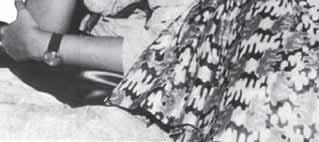

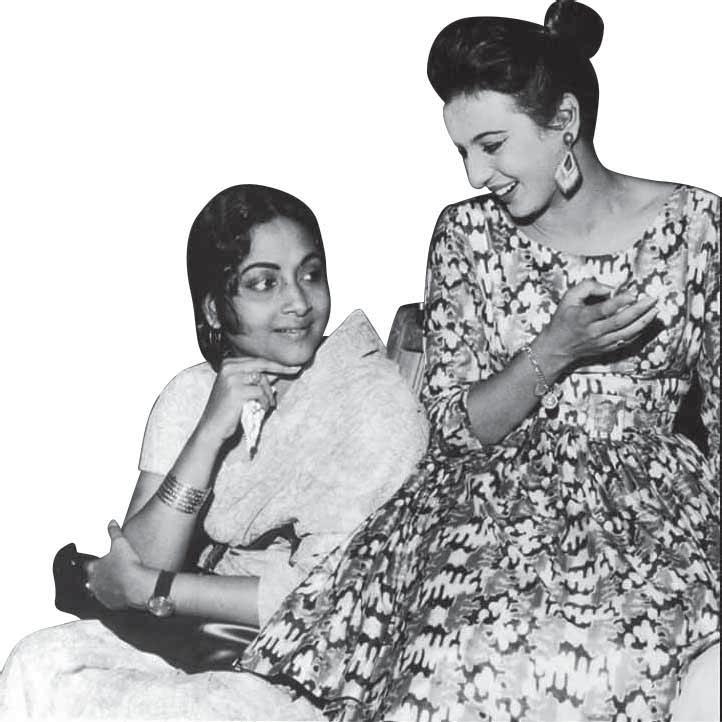
composer confessed that he had been unfair to Geeta.
But in the 1958 Howrah Bridge, a musical blockbuster, Nayyar gave Geeta one song, a cabaret number on Helen — Mera naam chin chinchu. This jaunty boisterous song outdid in popularity the three Asha solos of the film — including, incredibly, the wonderfully choreographed Ayiye mehrbaan, a signature song of both Madhubala and Asha Bhosle.
Amidst the turmoil at home, Guru Dutt made Kagaz Ke Phool in 1969, with Waheeda as heroine. Ironically, Geeta sang the timeless Waqt ne kiya in this film, about two tormented souls in love, seeking a fulfilment that was far off (music by S D Burman). Geeta’s pain-wracked voice and restrained emotion made it a heartwrenching song of despair. Lyricist Kaifi Azmi, cinematographer V K Murthy and director Guru Dutt also poured their hearts and their genius into the song. Result: a work of immortality that’s a muststudy exercise for all students of cinema. Waqt ne kiya figures in every listing of great Bollywood songs.
Unfortunately, the film bombed, and Guru Dutt ran into heavy debt.
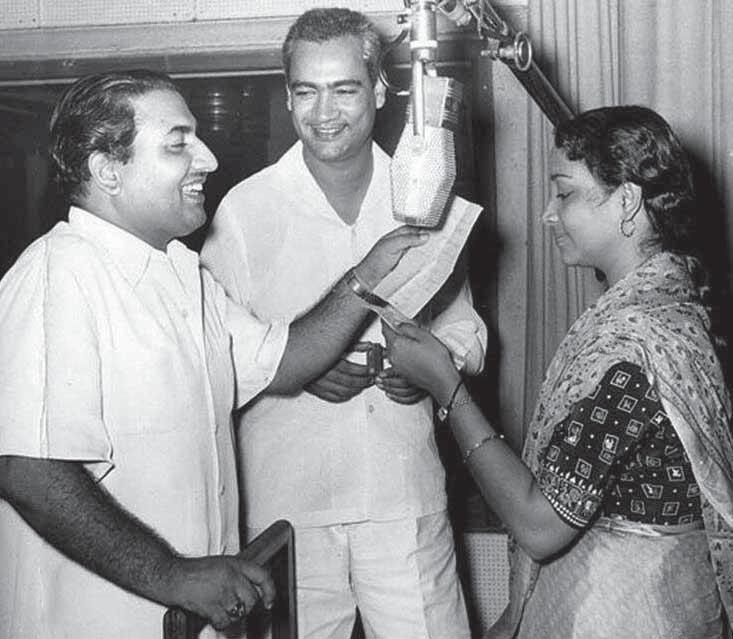
He rebounded within eight months, however, with the film Chaudhvin ka Chand (1970). The family’s finances improved but the Dutt couple’s estrangement grew, particularly because Geeta was given just one song in Chaudhvin ka Chand.
generally believed — after an overdose of sleeping pills. Geeta was shattered and inconsolable. She tried to support her family through live shows, but couldn’t give up drinking.





Geeta’s pain-wracked voice and restrained emotion made the song Waqt ne kiya a heartwrenching song of despair.
But Geeta sang two emotionally scorching solos in Sahib, Bibi aur Ghulam (1962), the next Guru Dutt venture, thanks to composer Hemant Kumar. He insisted that Geeta would be the voice of heroine Meena Kumari. How poignantly did Geeta portray Meena’s angst through the songs Na jao saiyan chudi ke baiyan and Koi door se awaaz de chale aao!
Sahib, Bibi aur Ghulam is today revered as a classic, and has won several awards, but it was a commercial failure on release. Guru was distraught. And Waheeda decided to withdraw from Guru’s life. In 1964, Guru committed suicide — or so it is
In 1971, Geeta demonstrated her incandescent talent for the last time through the movie Anubhav for which her brother Kanu Roy composed the music. Meri jaan mujhe jaan na kaho, filmed on Tanuja romancing Sanjeev Kumar, hypnotises one and all even today with “the voice that defies description”.
In 1972, Geeta departed. Alcohol took its toll, and she died of cirrhosis of the liver. But she had perhaps lost her will to live.
Mera sundar sapna beet gaya was one of Geeta’s iconic songs. Tragically, the song was her own epitaph.
The author is a senior journalist and a member of the Rotary Club of Madras South.








Why do we engage in war? Is it because very often political leaders don’t know what else to do?
The origins of Steve Killelea’s interest in peace — and war — can be attributed to a family foundation that worked with the very poor. This afforded him opportunities to visit places ravaged by conflict and interact with those affected. Along the way, he became an inventive and successful businessman. In his book, Peace in the Age of Chaos, he refers to a question that, metaphorically speaking, changed his life: ‘Which are the most peaceful countries and what can be learnt from them to help those countries that are not?’ The realisation that there were no simple answers here led to the launch of the Global Peace Index (GPI) in 2007, by which countries are ranked according to their levels of peacefulness. Research into one thing led to further studying other things, leading to fundamental insights about peace, people, conflicts and their causes.
Knowledge backed by resources prompted Killelea to set up the

Institute for Economics and Peace (IEP) in 2008, in Sydney, Australia. As he writes in the introduction to the book, ‘…understanding what creates peace is very different from understanding the causes of violence, or even how to stop it’. The IEP looked at new ways of thinking. The GPI threw up rich data.
That’s how the idea of ‘Positive Peace’ emerged. In contrast to Negative Peace which is basically the

absence of violence, Positive Peace ‘represents the attitudes, institutions and structures that create and sustain peaceful societies’. The concept is built on a framework of wellfunctioning governments, equitable distribution of resources, free flow of information, good relations with neighbours, high levels of human capital, acceptance of the rights of others, low levels of corruption, and a sound business environment.
The book draws attention to commonly held perceptions, such as the relationship between terrorism and religion, notions of progress, what constitutes political leadership, ideas of identity, and so on. In one instance, Killelea talks about a project that envisaged providing electricity to a village in Myanmar, in the hopes of making it easier for children to study, women to work at home, farmers to water their fields. However, the local community preferred to light up their pagoda. For them, ‘…respect for Buddha and his teachings was the best form of merit rather than short-term material gains’. Such experiences led to the realisation that it was important to work with existing values of a society instead of imposing external values on them. As he writes, ‘Diversity is a much-celebrated phrase today, but often means accepting a narrow set of Western progressive values.’ He and his team decided that the ethnocentric attitude had to go.
Then again, take the issue of immigration. Drawing attention to the nationalist backlash in 2015 when Germany took in about one million refugees, he points out that this constituted only one per cent of the German population, whereas ‘Australia has successfully absorbed the equivalent of 1% of its population in immigrants every year

for the past 50 years’. Debunking the connection between religion and terrorism, Killelea quotes from the IEP’s 2014 report that ‘…religion is rarely the key factor in conflict, although it did play a part in about 60% of conflicts. Other factors, such as corruption, state-sponsored terror against its citizens, growing grievances, economic inequality and political instability, are much more closely correlated with conflict. On the positive side, religion can play a constructive role in improving social cohesion’.
Incidentally, the first largescale Positive Peace workshop was run with Rotary International. Killelea recalls how at the start of the workshop, someone said, ‘Isn’t war just a natural state, and besides, if you are on the winning side, isn’t there lots to be gained from it?’ Killelea responded by asking the man how many of his family he would willingly see killed for a slice of power. When he asked who wanted to live in these conditions, not one hand went up.
Steve Killelea elaborated on some of the findings and themes of the book in an email interview. Here it is; a few questions have been edited for length.
Peace is an emotional subject which finds expression in terms of loss or longing. What are some fundamental causes for this? Peace has both an internal and external element to it. The internal element is expressed through all major religions where it is a central theme in all. If we look at psychology, again the aim is to improve our inner peace. Whatever the reason this internal drive to be free of afflictive emotions is built deeply into our psyche.
There is also the external perspective on peace and in many ways, it is governed by our internal sense of feelings of security, justice and family. A peaceful environment gives the best opportunity for our progeny to grow up and thrive. Therefore, often the structures of society, especially in democracies, but also other forms of government,
create rules to regulate behaviour and, providing individuals stay within these rules, they will be free from persecution and protected from violence.
Studies from anthropology have also found that there are a number of traits that societies share in common. Research has covered 60 societies. Five of these common themes from this research are: love of family, a concept of shared community identity, a sense of justice, some form of ownership rights, and a respect for authority. In many ways, we can see how these traits underpin our desire for peace.
In the book, you draw attention to the fact that we generally perceive peace in terms of the absence of violence, conflict, aggression. Please elaborate.
The problem with peace is that it is generally seen as the absence of something, rather than an active thriving state. This is mainly because the negative emotions associated with fear or loss are more immediate, therefore most of the energy goes into stopping the causes of these emotions. The problem is further compounded by our binary way of looking at things, such as war or peace; either you are in it or not. This doesn’t help for a more nuanced understanding of peace.

The first largescale Positive Peace workshop was run with Rotary International.
One of my more profound realisations is that when we say we are studying peace we are generally studying conflict, and that what is needed to stop conflict is different than what is needed to create resilient societies that do not fall into violence and can absorb shocks. These latter qualities are known as Positive Peace and that is what Peace in the Age of Chaos explores. But what is more profound is that the same qualities that create highly peaceful
societies also create many of the other things that we value, such as better economic performance, better performance on ecological measures, better measures of happiness and well-being, and better measures of inclusion. Therefore, Positive Peace can be seen as creating the optimal environment for human potential to flourish. This positions Positive Peace as central for development. In fact, countries that are improving in Positive Peace when compared to countries that are deteriorating have nearly three times higher GDP growth per annum.
Why are we so fearful of immigrants, particularly in the West? Are we afraid that what happened to the American Indians and Aborigines and Jarawas and millions of indigenous peoples will happen to ‘us’?
Human emotions run deep and are often in conflict. Most religions are filled with stories of the battle within over conflicting emotions. Most humans feel both love and hate, and often towards the same individual. Reducing complex phenomena to simple narratives can be dangerous.
Peace is generally seen as the absence of something, rather than an active thriving state. This is mainly because the negative emotions associated with fear or loss are more immediate, therefore most of the energy goes into stopping the causes of these emotions.
Certainly, group identity is important. Immigration, if it is of sufficient numbers, can be seen as a challenge to the group identity and can create push back. However, there are many factors that come into play. In many western countries working conditions and wages are falling. This creates an environment where an influx of people means more competition for jobs and wages, creating a backlash.
Generally, immigration is viewed more favourably than asylum-seekers, therefore setting up procedures so that refugees are brought in as immigrants will lessen some of these tensions. But for many western countries birth rates are falling and without immigration their GDP will shrink. I can’t imagine a politician going to an election saying that GDP will only shrink by one percent this year. But this brings up a bigger point about GDP growth being the measure of human progress. Immigration in the west is unlikely to stop anytime in the near future.
Despite advances in technology that have made us more connected, we are getting increasingly intolerant. How can we get past such attitudes?
The Internet generally has been a big positive for society. We now have access to information we could have never dreamed of having even 20 years ago; however, there are some downsides. Misinformation and echo chambers are certainly issues, as is hate speech.
I would argue that to move past intolerance we need to become more focused on what we have in common. The more we focus on differences the more likely we are to accentuate differences to the point where we only see people with different views as dangerous.

One of the aspects of Positive Peace is that it is systemic. In other words, societies operate as systems and in many ways, this is very different from the current view of how societies operate, which can be expressed as cause and effect. In systems theory, societies are seen as being path dependent where the relationships and flows within the society determine future events. We have found in workshops on Positive Peace that when using a systems approach, groups that have been in conflict come together and can get to common solutions because when looking at a problem the aim is to think forward rather than backwards. Thinking backwards often results in recriminations.
Is there a way of maintaining a sense of continuity with regards to positive systems that keep the peace? Or will this have to be reinvented every time?
Systems are self-perpetuating — once they are moving in a particular direction the processes tend to become self-reinforcing. This is what is called virtuous or vicious cycles. As already mentioned, systems are

path dependent, therefore the aim is to nudge the system with multiple interventions from many directions. The Positive Peace framework provides the blueprint for how to do this. What needs to be done will vary from society to society as they are unique and on their own unique path. Although systems are different there are common approaches and some systems are more similar than others. The Positive Peace framework provides an approach for analysing a system and developing appropriate nudges or interventions to kick-start these virtuous cycles.
The world appears to be going through a crisis of leadership. Yes, there’s one Jacinda Ardern, and there was one Angela Merkel. What makes for a good leader? From my perspective good leadership is simple. Leaders need to be highly skilled in whatever they are managing; they must also be compassionate. Often when looking at political leadership we want someone who is tough, who can cut through the issues to be effective, but without well-developed compassion the decisions are more likely to be self-centered or even dangerous. However, compassionate people without appropriate knowledge tend to be ineffective. Therefore, for good leadership, both the head and the heart need to be combined. Often, we just look at the head.
Is dismantling the military a solution to building more peaceful societies?
We do not live in a peaceful world and it is unlikely to be truly peaceful anytime soon, therefore we do need the military. The bigger question is what is the right size for the military and how should it be used. One of the key questions is when is military action justified. For example, most people would agree UN-sanctioned peacekeeping operations are justified. If a country is attacked what level of response is deemed appropriate. This is another difficult question to answer. Also, what is the correct size for the military. In many ways this can be a subjective figure based on how free the population of the country is from fear.
If we look back on the last 20 years, most of the major global conflicts could have been avoided. Iraq, Syria or Libya, for instance. The aim was to overthrow ruthless tyrants, but what was left in their place was chaos that caused more human suffering than what preceded the wars. The issue here was not the military but the political leadership that couldn’t secure peaceful transitions, therefore future wars need to be approached with extreme caution.
Do we ever stand a chance of achieving peace?

For good leadership, both the head and the heart need to be combined.
Peace is a relative concept – it only stands in comparison to something else. However, we can measure the current level of peace globally or within a country. If we set the target of creating a world that is 10 per cent more peaceful then that is well within the bounds of what most people would consider possible. To do this would mean tackling many of the world’s major conflicts and not start any new conflicts. But given the state of international rivalries, there
will be more wars. International bodies do help, such as the UN, OSCE and others, but many of these bodies are out of date and need reinvigorating. The UN Security Council would be a good start.
Violence comes at a huge cost. The cost of violence to the global economy was $14 trillion in 2020; this is over 10 percent of global GDP and these figures are conservative. A 10 percent reduction in violence would be equivalent to adding three new countries to the world the size of Ireland, Switzerland and Denmark. Another way of looking at this is that all overseas developmental aid (ODA) in 2020 was equivalent to roughly one percent of the global economic impact of violence.
As I write in Peace in the Age of Chaos, the desire to live in a safe, sustainable and prosperous world is universal. I believe it is achievable if we use a more expansive understanding of the concept of peace. It is a peace that is practical, one that recognises threats and believes a level of military action is needed. One of the important qualities of Positive Peace is that it creates societies that are more resilient. In other words, better capable of adapting to their changing environments. This is especially needed in the 21st century as the planet’s ecosystems are stretched by the sheer number of people inhabiting it, pandemics, such as Covid19, or because of the technological changes reshaping work and the way people interact.
Positive Peace, when combined with systems thinking, provides a new and exciting theory of change. It’s a new way to conceptualise how societies function and a new approach to solving our most intractable problems.
The columnist is a children’s writer and senior journalist.

Author
: Somnath Sapru
Publisher : Vij Books India
Pages : 340; `1,250
During the first two years of the war the Royal Flying Corps that had been set up as part of the British Army suffered heavy casualties on the Western Front in Europe. The British government was especially looking for volunteers for the flying service. This book is a story of five Indians who volunteered in World War I for flying services in the Royal Flying Corps. Four of them flew combat planes in the Royal Flying Corps in France, Belgium and Italy during the war, at a time when Indians were considered unfit to operate a screwdriver or drive a car. The volunteers including a technician, all from affluent families had no need to volunteer, but they did so and were accepted, trained and sent into battle.
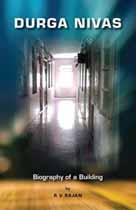
Nivas - Biography of a building
Author : RV Rajan
Publisher : Creative Workshop
Pages : 152; `290
Basedon the author’s experience of living in a chawl in Mumbai for the first 26 years of his life this book will take the readers into the tiny one-room kholis of Durga Nivas, a fictional chawl in Matunga, Mumbai. The chawl is home to a potpourri of people from different parts of India, who lived in close proximity, sharing joys and sorrows; like one big joint family. Conversations by the common toilets, where people stood in a queue holding an empty paint and Dalda tins in their hands, the rumble of trains playing like background music in the complex’s courtyard, fights between children escalating into fights between the respective sets of parents; this book brings alive the life of nine families who lived on the first floor of Durga Nivas from the 1940s into the 21st century.

Author : Greer Macallister
Publisher : Sourcebooks
Landmark
Pages : 408; `2,120
In1853 Virginia Reeve is summoned to Boston by Lady Jane Franklin who wants her to lead a group of 12 women to the Arctic. Lady Franklin expects the women to find her lost husband Sir John Franklin, his expedition party and two missing ships. Virginia has experience as a guide leading travellers to Oregon but this is a different journey into one of the world’s harshest environments. Each of the women in the group is picked for their individual skills; a real mixture of ages, personalities and backgrounds. The story is about how this diverse group of women get along and undertake this hazardous trip. The story has an alternating timeline — it goes between the journey to the Arctic and eighteen months later in Boston where Virginia is on trial, accused of kidnapping and murdering socialite Caprice Collins.
Compiled by Kiran Zehra
RC Spic Nagar, RID 3212, on its 47 th year of charter, has various ongoing service projects, with major focus on providing healthcare.
More than 100 children are living a healthy life thanks to the annual paediatric heart camps being conducted by the club since the past five years. The club, in association with the Tuticorin Public Welfare Centre, organises cardiac screening camp for infants and young children and sponsors corrective surgeries for needy patients at the Apollo Hospitals in Chennai. “We take care of the entire cost including travel, accommodation, food and hospitalisation,” says the club’s past president Radhakrishnan. Its artificial limb and mobility aid distribution camps have benefitted at least 300 physically-challenged people in the last five years. The limbs are manufactured and provided at subsidised cost by Rotary Coimbatore Midtown Artificial Limb Centre. Technicians from the centre visit the camp and take measurements from beneficiaries for artificial limbs, and provide support in fitting the limbs and training the users to walk. Each year the club spends ` 5 lakh for
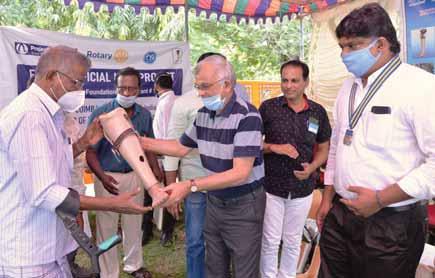
this initiative. The beneficiaries are identified by the Tuticorin District Rehabilitation Centre for the differently-abled and the Paralympic Association.
This year the camp was organised with global grant support from
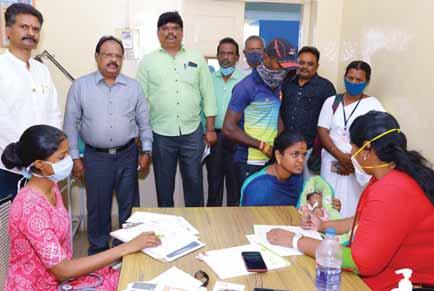
A paediatric heart screening camp in progress.
RC Melawati, Malaysia, RID 3300. A M Foundation, Chennai; SPIC and Greenstar Fertilisers partnered with the club. SPIC’s wholetime director S R Ramakrishnan and COO E Balu presided over the camp which benefitted around 80 people.
The club, in association with the Aravind Eye Hospitals, organises eye camps, sponsors cataract surgeries and distributes prescription spectacles for the underprivileged every year. General medical camps and blood donation camps twice a year are its other long-running healthcare programmes.
“Schoolchildren look forward to our science exhibition every year. We have been organising it for several years and 400 students participate,” says club president Mutharasu. The club has been hosting an annual RYLA for the past six years. It has a participation of at least 50 girls from 10 colleges.

We all know change is inevitable. There is a Japanese term
I’m very fond of, it’s called Wabi-Sabi. It simply means, nothing is permanent, nothing is perfect, and nothing is finished.
Keeping that in mind, how do we cope with change in the best possible manner to grow rather than get paralysed by anxiety? How can we use change to our advantage?
Everyone has experienced some degree of change, especially over this last year with the pandemic. There have been losses and stress to contend with.

Change can be exciting, or it can be daunting, sometimes devastating. From major life changes like a change/loss of job, marriage, divorce, moving home or a pandemic to smaller changes like

Sheela Nambiar
buying a new car, changing the furniture in your home or even cancelling a subscription to a magazine/journal, any change can bring about a variety of emotions that can either move you forward or keep you petrified with doubt.
Change exposes our fears. Especially our fear of lack of control. We all want to feel a sense of control over our lives, but the truth is, there isn’t much we can do to have control over. When we understand this and be more accepting of change, we will find it easier to adapt and roll with the tides.

that help
Accept change graciously: Change is an essential part of life. Welcome change: If you learn to internalise that change is inevitable you are less likely


to be shocked and traumatised when it occurs. This does not mean you’re always waiting with bated breath for the other shoe to drop, which can be stressful in itself. It means you have a healthy acceptance of situations as they unfold.
Learn from change: There is much to be learnt as we move along in life. We can learn from it. Hone new skills, get a different perspective and make the best of it. Our brains are constantly rewiring as we think or do things differently. This ability of the brain, called neuroplasticity, can help us adapt better.


Focus on the positive but be aware of the negative: Every situation has both negatives and positives. While we need to be clear on the negative aspects





of the changed situation (perhaps the new home you’ve moved into is further from your workplace), one needs to focus on the positive (it’s in a better neighbourhood and closer to school for your children).
Grow with change: There is always an opportunity for growth. If you seek out these opportunities, there will be growth. For instance, the end of a marriage or relationship, while devastating, may be an opportunity to explore your own individuality, get a new job, study more or move to a new city. It may be an opportunity for selfexploration which was possibly stifled in a dysfunctional relationship.
* I can’t do it on my own
* I feel so sorry for myself
* Life is unfair.
Carol Dweck, a professor of psychology at Stanford, talks about the ‘growth mindset’ in her book, Mindset: the new psychology of success. In it she states “In this mindset, the hand you’re dealt is just the starting point for development. This growth mindset is based on the belief that your basic qualities are things you can cultivate through your efforts.”

Know that humans can be enormously resilient: Resilience, the ability to bounce back, withstand setback/ change and be even better than before is a skill. Some people seem adept at it while others tend to tailspin easily when faced with challenges. Resilience however can be a learned skill. Have confidence in yourself that you can cope with whatever change that comes your way.
Thoughts that resist change
* This wonderful situation will never change
* My life will always stay this way
* All this is ‘mine’ and mine alone
* This is all I know and all I’m willing to know
* I’m too old to change

Learn and grow and if it is a
A growth mindset is essential when faced with change. When you have a fixed mindset instead you tend to avoid challenges, give up easily, see effort as futile, tend to ignore feedback if negative and feel threatened by the success of others.

Continue (or develop) practices that ground you: Practices like regular exercise should be continued through periods of change. It may be just an hour walk, but the fact that you are able to continue with a practice that you were used to, and you have control over, will ground you during times of change. If exercise is not something you practised regularly, this may even be a time to start. We all know exercise improves mood. A positive frame of mind will help enormously in shifting times

* I can’t think differently
* I’ve put all my eggs in this one basket. If I lose it, it’s the end of everything
* It’s too difficult
* I’m too comfortable in this situation. I cannot be comfortable in any other
* I cannot and will not do anything else
* I feel incapable of learning new skills

Eat healthy: You may have a tendency to binge eat or eat junk food when anxious. Eating healthy, nutritious food at times like this will also keep you feeling good and the mental faculties sharp. Brain fog is common when you overload on refined carbs. Gaining weight is inevitable if you indulge often or eat mindlessly. All of this only adds to the discomfort of change.

Connect socially: Stay connected with authentic relationships. Getting support from close family/ friends is essential in times of change. This would mean putting in the effort to stay connected. Research has shown that strong social support reduces stress. Get enough sleep: It is common to lose sleep when anxious or troubled. Loss of sleep can also compromise thinking, make you depressed and cause overeating. Stay mindful: It’s easy to become overwhelmed and mindless during times of perceived stress. Practices like mindfulness meditation help enormously in this regard.


Stay lighthearted: Sometimes it’s good to be able to laugh at a situation and see the humour in it. This obviously depends on the situation (you wouldn’t want to be humorous at a funeral for instance), but very often, when we look at the lighter side of life and don’t take ourselves too seriously, it gets easier to handle what comes along.
Change can be enormously challenging and gratifying depending on your perspective. The ability to adapt and grow instils a sense of confidence in us. Learn and grow and if it is a difficult time you are going through, remember that ‘this too shall pass’.

The author is a lifestyle medicine physician. sheela.nambiar@gmail.com www.drsheelanambiar.com

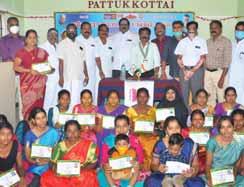
Club president M S Selvaraj presented certificates to the second batch of trainees who completed a three-month course at the club’s tailoring centre.
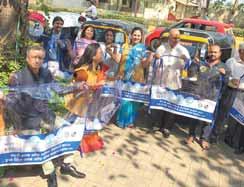
Safety net partitions were fitted in around 200 autorickshaws as protection against the spread of coronavirus. DG Shabbir Shakir participated in the distribution drive.
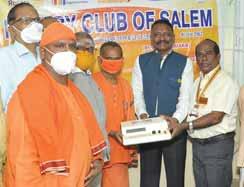
An IFT equipment worth `35,000 was donated to the physiotherapy unit of the Ramakrishna Mission Dispensary, Salem, in the presence of club president G Kamaraj.
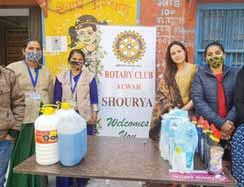
Sanitation materials such as phenyl, toilet cleaning solutions, handwash liquid and sanitisers and sanitiser stand were donated to the Rajkiya Uchh Prathmik Vidyalaya at Chouki Sheikh Sarai.

Club president Aniel Sahni handed over a platelets separation equipment to the Rotary Blood Bank, Delhi.
Twenty-five dustbins were installed at the windfarm beach and at the Topansar lake site by the club in partnership with the Nature Secure Society.
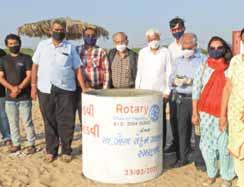
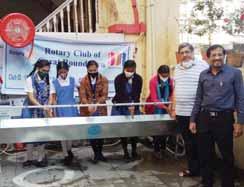
Handwash stations were donated to three schools under a district project and a handwash demo was held for students.
A walkathon was organised, in association with the Max Hospital, on World Peace Day. Apart from Rotarians, around 500 people took part in the event inaugurated by SP (Sambhal) Chakreshwar Raj.
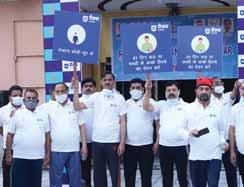
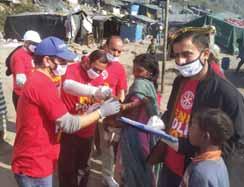
The club members participated with the local health department to adminisiter polio drops to 80 children in four slum colonies on an NID.
A mega medical camp was held in partnership with the Malhotra Nursing Home and Smriti Sanstha.
Around 200 women were screened for ailments. An awareness session on cervical cancer was held.
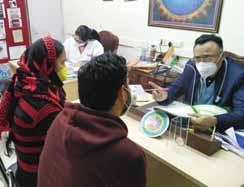

A health check-up camp was held at the Sidharth Hospital which benefitted the elderly and the sick in the town.
Around 100 blankets were distributed to needy people at the bus stand, railway station, hospital and other places.

RC Solapur — RID 3132RC Kushalnagar — RID 3181

A Rotary Cycle Bank Project was inaugurated on Women’s Day. The first five cycles were handed over to B M Pulli Kanya Prashala.
The club, along with the JSS Dental College, distributed white canes and radios to visuallyimpaired persons. DSP H M Shailendra was the chief guest at the event held at the Rotary Hall.
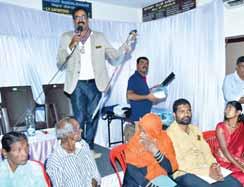
RC Chandanagar RC Puram — RID 3150RC Shimoga — RID 3182
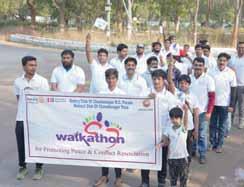
A peace walk was conducted to mark the 116th year of Rotary at the BHEL stadium. The club members created awareness about Rotary and its activities among the public.
A Rotary mammography centre in memory of Rtn Dr B Ventaka Rao was inaugurated through a GG project (`78.77 lakh) with RCs Fort Collins-Breakfast and Fort Collins After Work.
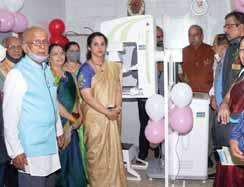
RC Vishrambag — RID 3170RC Cochin Beachside — RID 3201
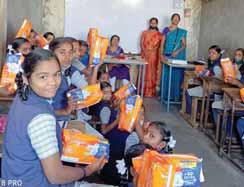
The club organised a menstrual hygiene awareness session at the Pasaydan School, Sangli, and distributed sanitary napkins to the students.
Covid care equipment worth `7.75 lakh were handed over to the government district hospital, Aluva. The project was funded by Aspinwall as part of their CSR initiative.
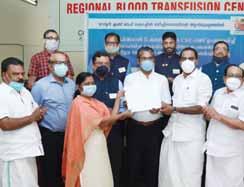

Bedsheets were given to visually-impaired women at an old age home in the presence of club president M Ramasamy and IMPA, local chapter, president T Sivasubramanian.
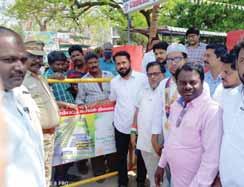
IPP Jaweed Khan handed over road barricades to the local police station during the Road Safety Awareness programme at the Green Valley School. Rtn Aliyar Ameen Ahmed gave helmets to bikers.

The club sponsored cataract surgery for 55 patients at the Netra Nidan Eye Hospital. Past president Dr Rakesh Kumar performed the surgeries.
Jackets were given to conservancy staff at the Chhend colony in the city. Around 100 blankets were distributed at an orphanagecum-school.
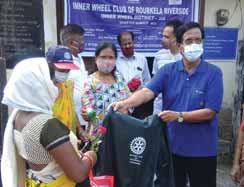
Around 70 students were screened for dental diseases at an oral hygiene camp at the Bireswarpur Government High School in Mayurbhanj. It was followed by an awareness session.

The club hosted cyclist Mahesh Kumar during his halt in the city. He was on a solo mission (6,000km in 30 days) to promote ‘clean, green and literate India’.
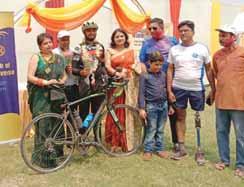
Compiled by V Muthukumaran
Last month, after a very long time, we got lucky. We travelled to Switzerland to see our grandson who was born last year in July. My son is doing research at a university there. But because the Swiss were not issuing any visas we were unable to go. Then suddenly in January this year they decided that if a child had been born, grandparents and siblings could visit. It was a special purpose visa, valid for six months. We applied when all the detailed documentation was complete. It included the baby’s birth certificate and other proofs. The visa came in a week. And we finally took the Emirates flight from Delhi to Geneva in early March. Earlier we used to take Swiss Air but it’s not flying to and from Delhi these days.
The Emirates routing was via Dubai naturally and so here’s the first warning. Although the flight was superb — despite the masks and face shields throughout the flight— in Dubai the airport experience was the opposite. The separation of westbound flights from others is such that you have to walk for between 35–50 minutes to get to the gate of your connecting flight. It took us 43 minutes and 3,978 steps on the way out. The same thing happened on the way back. Fortunately, on both occasions, we had a lot of time — two hours outbound and four inbound. But you know what?
If you are travelling economy there’s no place to sit while you wait, except in the holding areas at the gate. Those open only an hour before the flight. The restaurants are the only option but how do you spend four hours there? So if you are travelling west via Dubai, be warned. For older people the experience is unpleasant. I believe Frankfurt airport also makes you walk a long distance.
But Geneva was the opposite, at least where walking is concerned. It’s a small airport, only a little bigger than Kolkata or Chennai. But unlike on previous occasions when we landed, there was no aerobridge this time. It was very cold as well. We were loaded on to buses and with no regard for distancing. Later we found that very few people wore masks except when inside an enclosed space like a shop or train. Our flight landed after dark and we

took an Uber taxi to Lausanne where my son lives. It’s about 80km from Geneva. It came as a small shock to see that the Swiss highways, unlike in other west European countries, are not lit. It was pitch dark all the way. We quarantined voluntarily for three days in an Airbnb flat. That was not much fun because we were so anxious to see our grandson.
In Dubai we were told we needed four and not two copies of the self-declaration form on Air Suvidha. Two extra copies cost us 60 dirhams - `1,200!
But after such a long flight we didn’t want to take any chances. Before we moved to my son’s flat we took a corona test. It is quite expensive but nothing compared to the cost of the RTPCR test we had to take 72 hours before returning — a shocking `12,000 per person. In the UK, I was told, they charge 250 pounds per person! It being Easter weekend, all testing centres in Lausanne were booked. So we had to travel 30km by train to a nearby village. That added another `6,000 to the cost which came to half the price of one ticket to Geneva and back. On our way back, before boarding for Delhi in Dubai we, along with several other passengers, were told we needed four and not two copies of the self-declaration form on Air Suvidha. Two extra copies cost us 60 dirhams at `21/dirham or a little over `1,200! Clearly, everyone is scalping travellers.
But you know what? Our grandson made it all worth it. Who cares about a little money?
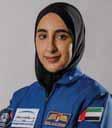

Kongthong, a village 65km from Shillong in Meghalaya, has a special language of whistles. For centuries, the village has nurtured the whistling code, called Jingrwai Iawbei where a mother chooses a whistle tune for her newborn. As the child becomes man, the tune becomes his identity. The elders in the community are hoping that with the help of a UNESCO heritage tag and a school they will be able keep the whistling tradition going. Meghalaya has long been trying to get the whistling nomenclature system on UNESCO’s list of Intangible Cultural Heritage of Humanity. Recently Sanbor Shullai, South Shillong MLA, wrote to the Intangible Cultural Heritage of Humanity Centre seeking the heritage tag for Meghalaya’s oral tradition that has just 700 surviving practitioners now.

Ramesh and Kalpana Bhatia, an Indian-American couple from Texas, US, donated `1 crore ($150,000) for ramping up healthcare facilities in Bihar and Jharkhand through the Bihar Jharkhand Association of North America (BJANA). The donation will be used for healthcare infrastructure in the rural areas of the two states through the Pravasi Alumni Nisshulk (PRAN) — an initiative by like-minded Indian-American physicians who are working to provide healthcare to the underprivileged in Bihar and Jharkhand.

During these scary times everybody wants to avoid going to doctors’ clinics or hospitals, for fear of getting the Covid infection. While many routine check-ups can be postponed, diabetics can’t afford to do so. “With this in view, we have come out with an app named ‘diahome’, which you can download on your phone, and book an online appointment with either me or any of our diabetologists,” says Dr A Ramachandran, chief of A Ramachandran Hospitals, Chennai. A Rotarian, he is a member
The UAE has named the next two astronauts in its next space programme, including the country’s first female astronaut, Noura al-Matroushi. She and her male counterpart Mohammed Al-Mulla were shortlisted from among 4,000 applicants in the UAE. Noura (28) is an engineer at Abu Dhabi’s National Petroleum Construction Company and Al-Mulla (33) is a pilot with the Dubai police. Both of them will undergo training at NASA’s Johnson Space Center in Houston, Texas. In February the country put a satellite Amal (Arabic for Hope) in orbit around Mars and hopes to launch an unmanned spacecraft to the moon by 2024. It also has plans to build a human colony on Mars by 2117. Compiled by Kiran Zehra; Designed by Krishnapratheesh S

Banas Dairy in Banaskantha district, North Gujarat, set up an oxygen plant in 72 hours flat to help its district medical college tide over severe shortage of oxygen. The management decided to become atma-nirbhar when the dairy-supported Banas Medical College and Research Institute in Palanpur ran short of oxygen for 125 Covid patients, and managed to get some cylinders after much struggle. The new plant has a capacity to daily generate 680 kg of medical grade oxygen with a purity of 93-96 per cent and that can serve 35-40 patients a day. The dairy plans to set up two more plants in the district so that the medical team can focus on the core work rather than waste its energy on hunting for oxygen.
of RC Madras Central. Once the appointment is booked, a hospital representative asks the patient to keep ready the latest blood sugar reports, the medicines/insulin taken, etc and the next day the doctor is connected to the patient through a video call. “This way there is no unnecessary travel or commute, which is risky, and the patient’s diabetes management is also monitored,” says the diabetologist. The hospital also organises blood tests at home, and delivery of medicines. (more info on care@diahome.com).
Regn. No. TN/CCN/360/2021-2023
Licensed to post WPP No.TN/PMG(CCR)/WPP 431/21-23
Total number of pages in this monthly issue, including cover, 84. Price: `35
Registered with Registrar of News Papers for India 3880/57 Rotary News Published on the first week of every month
